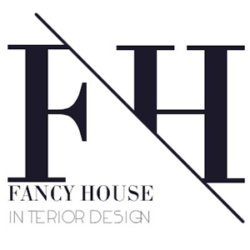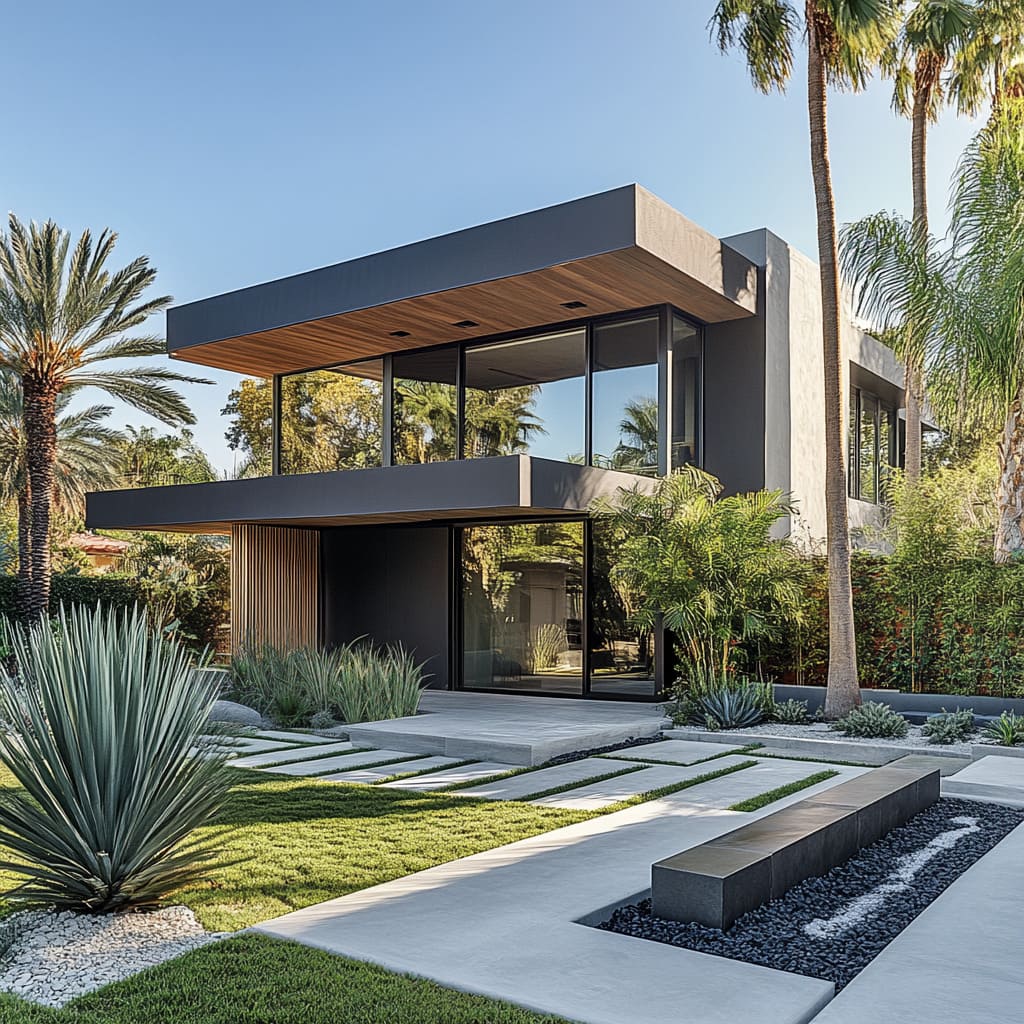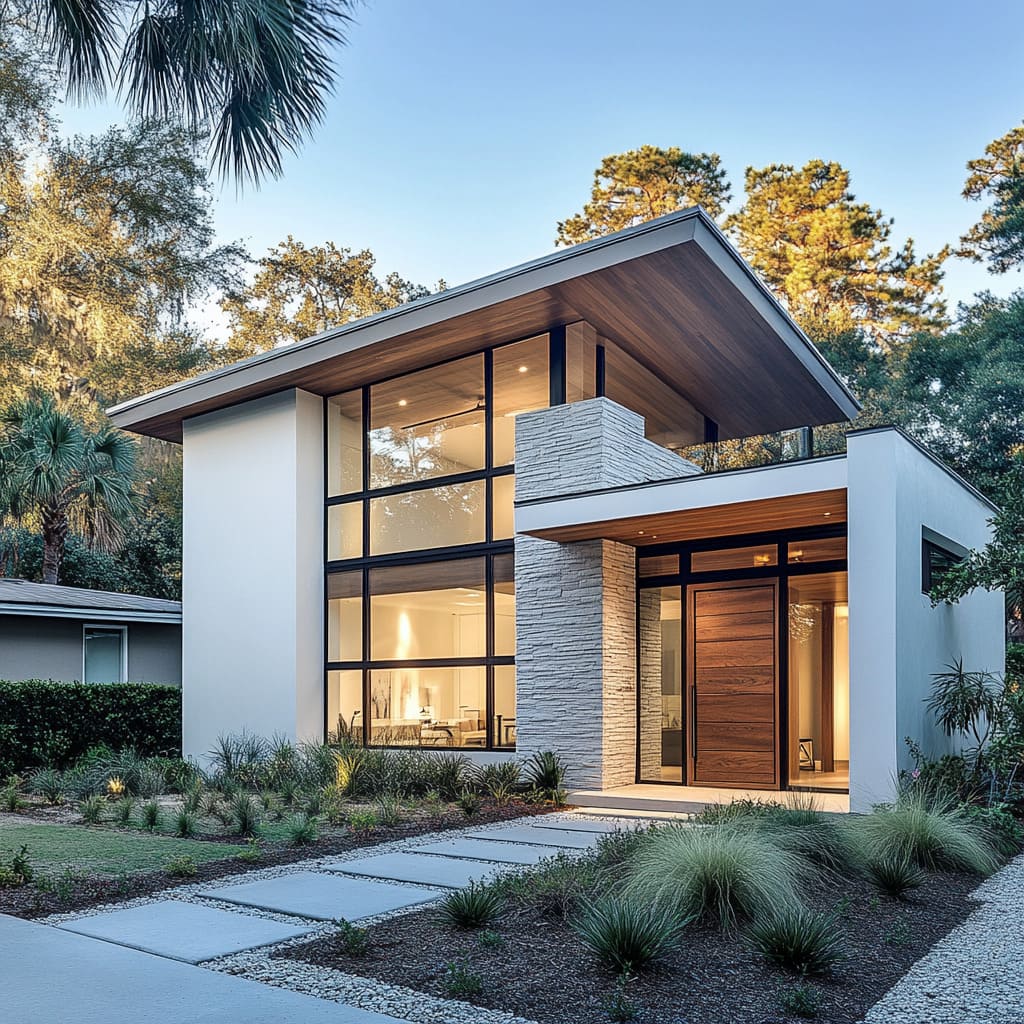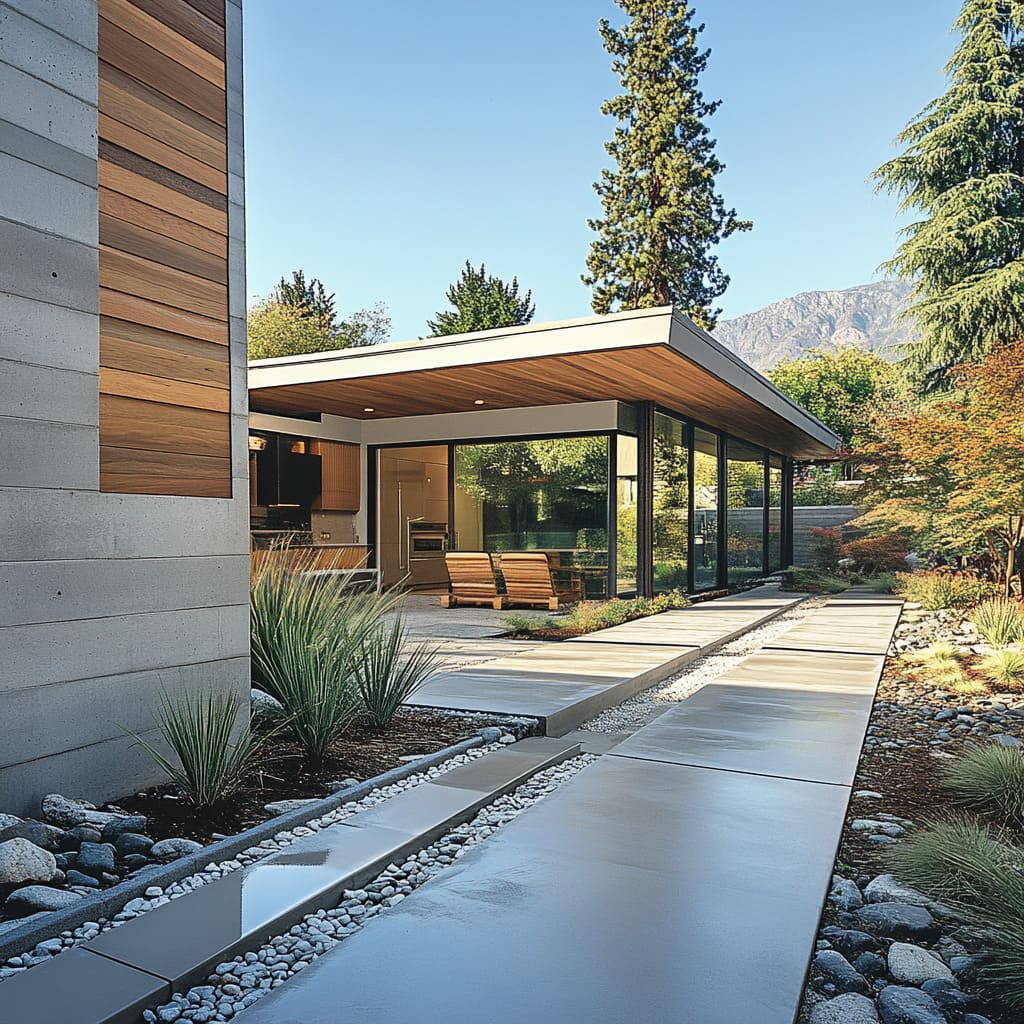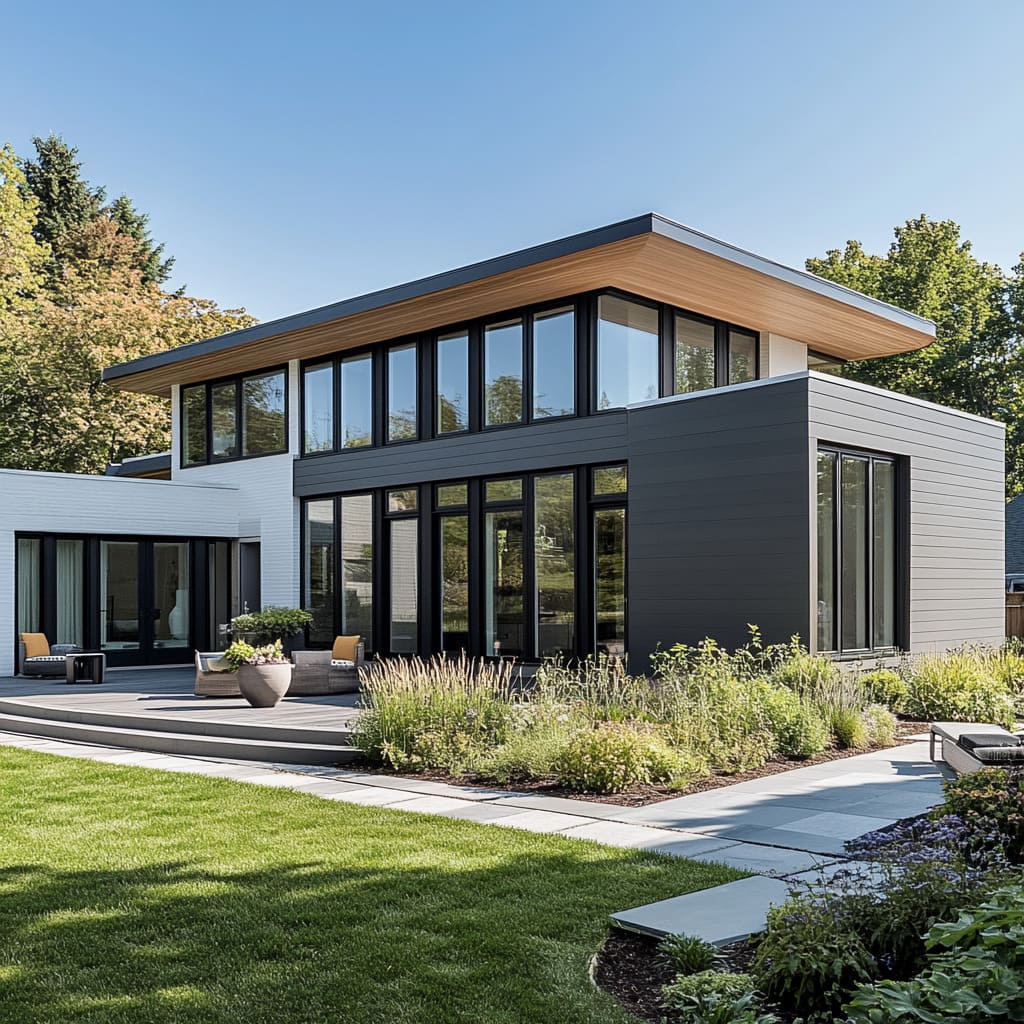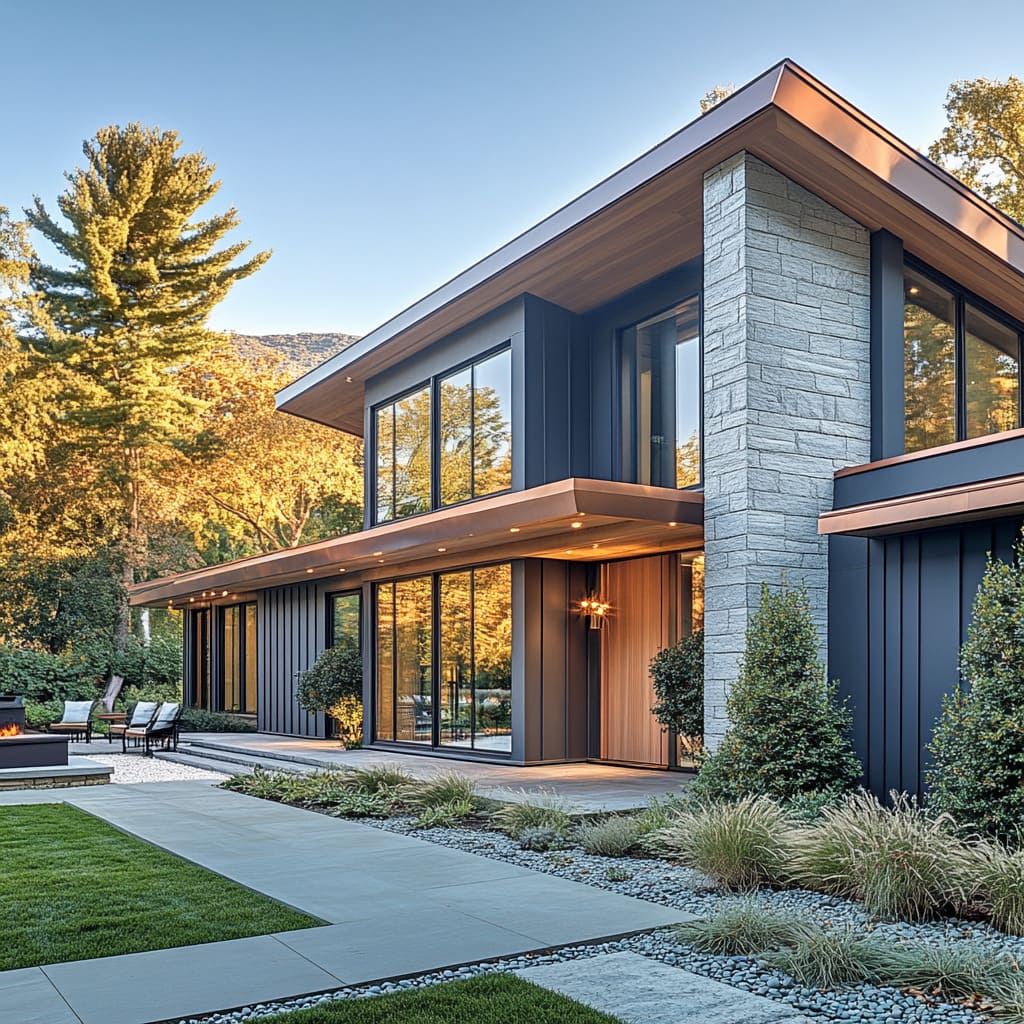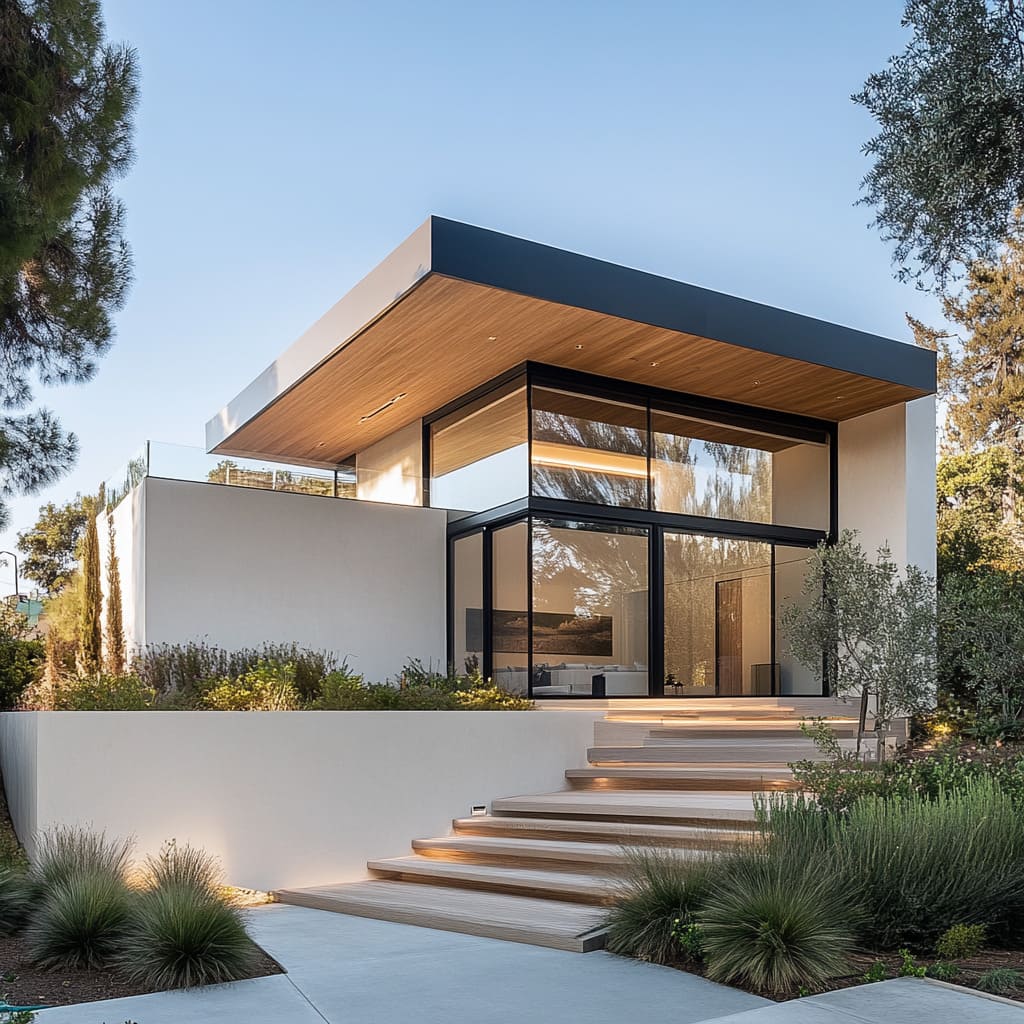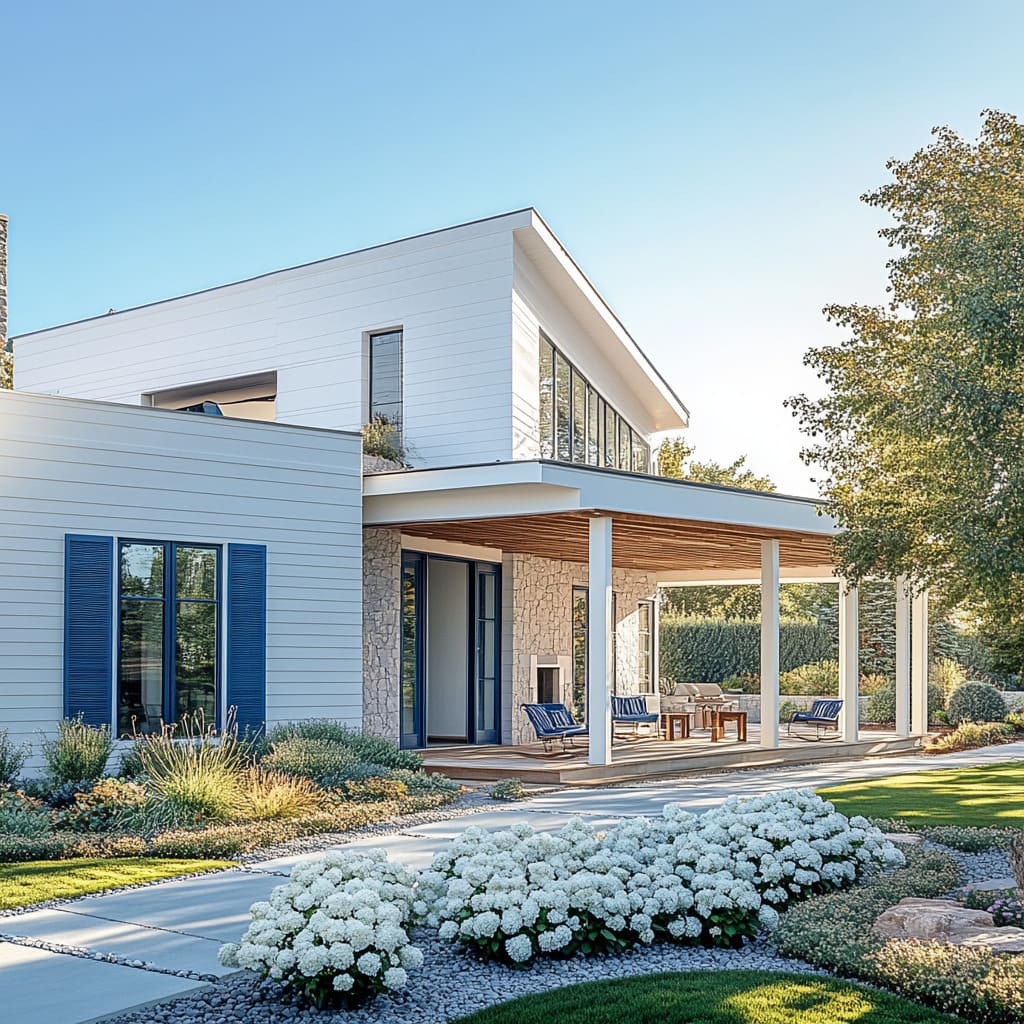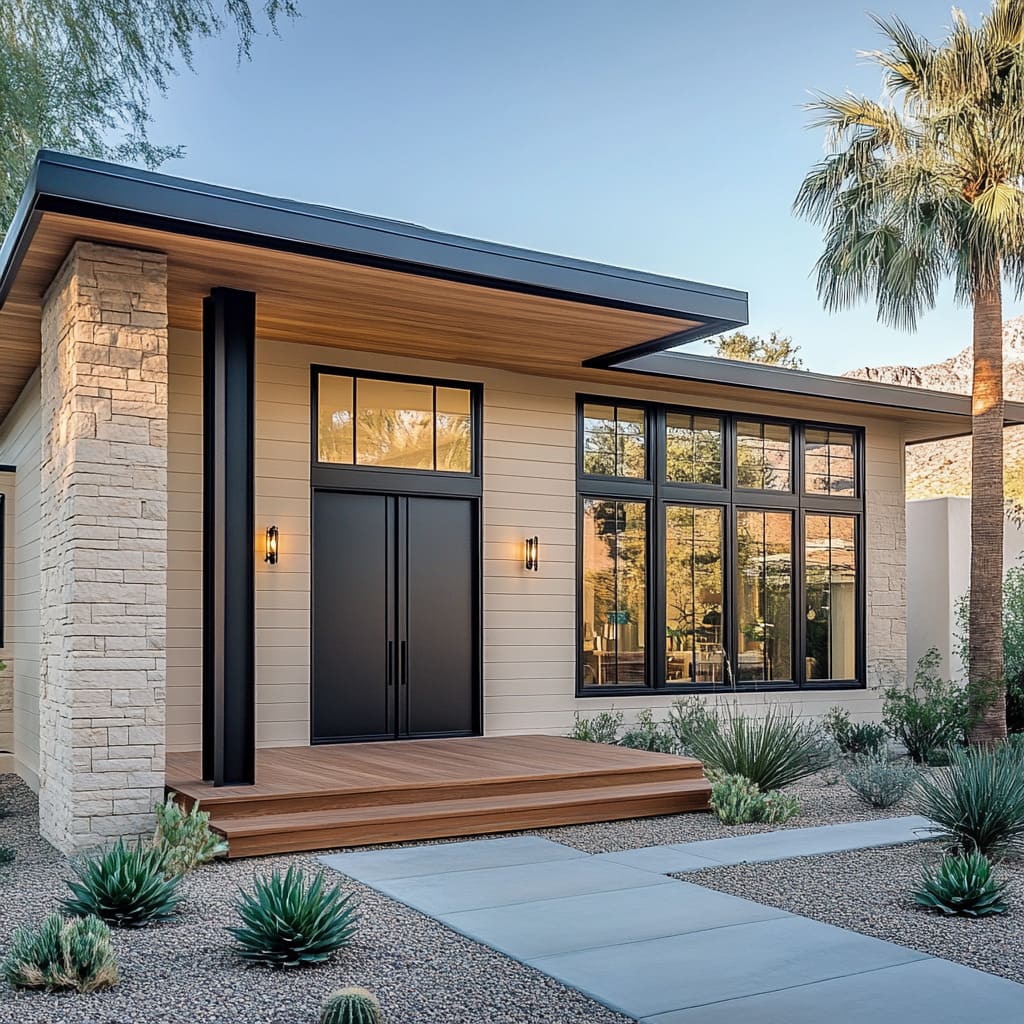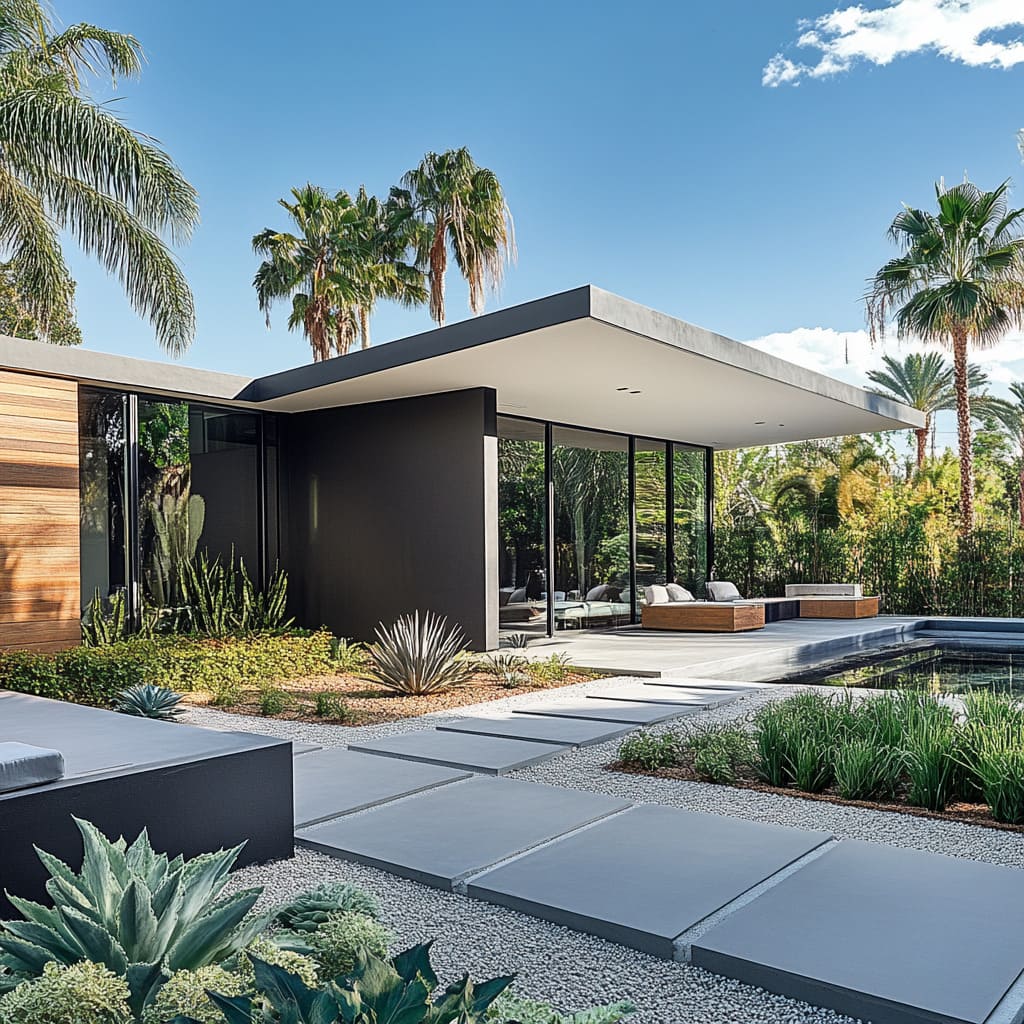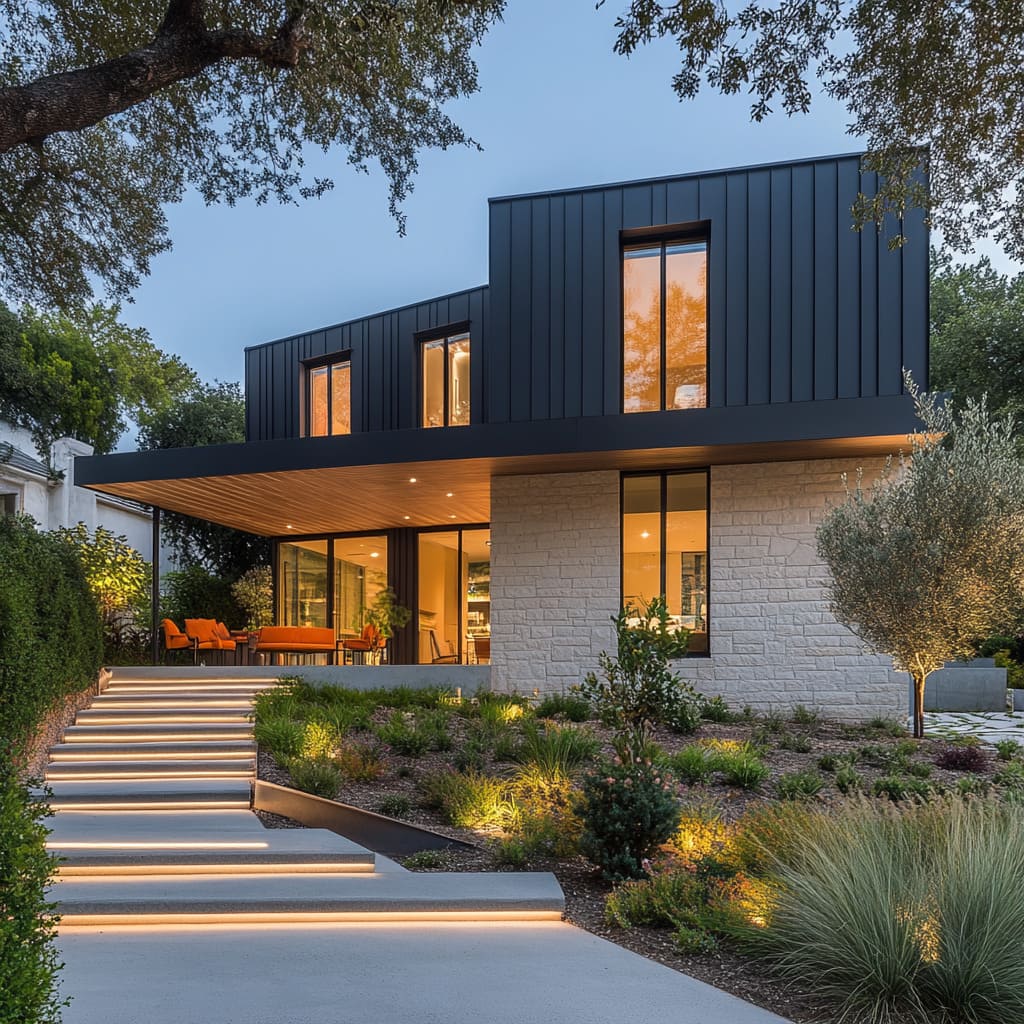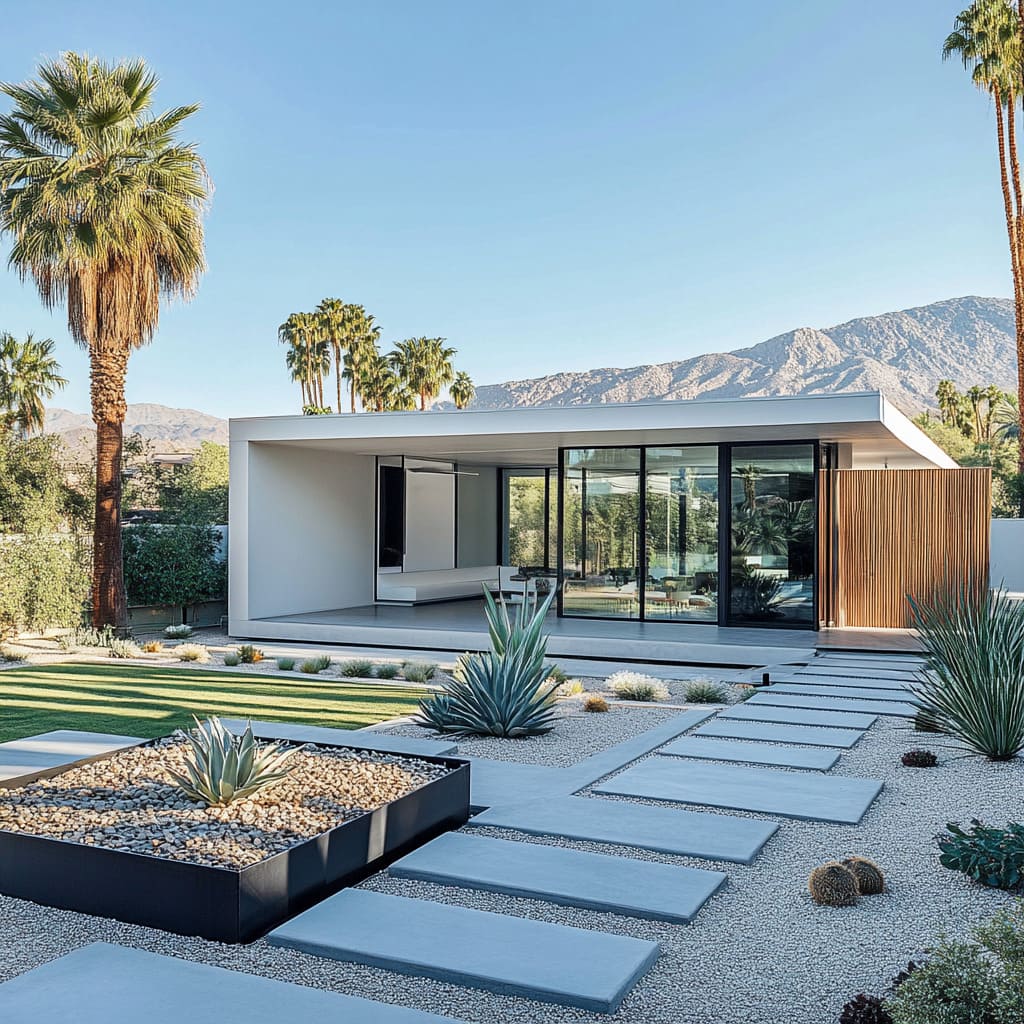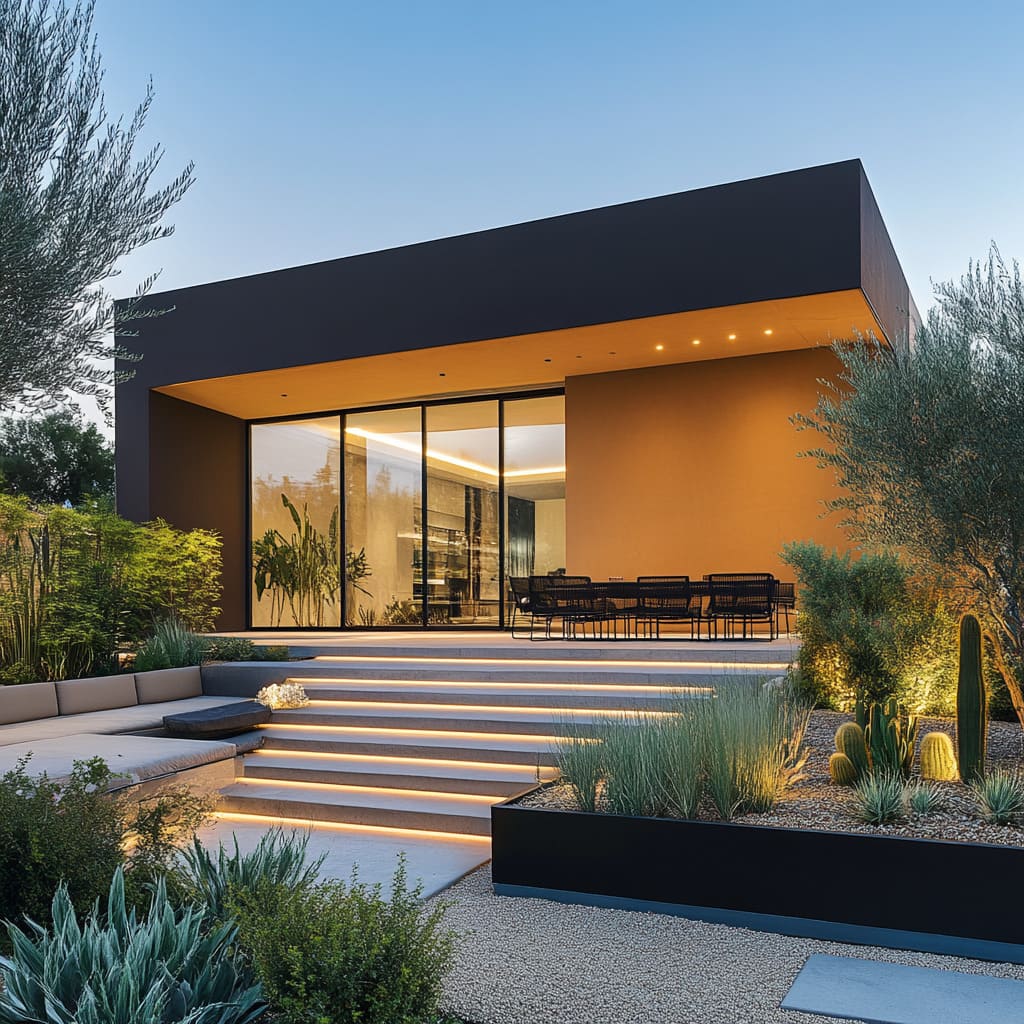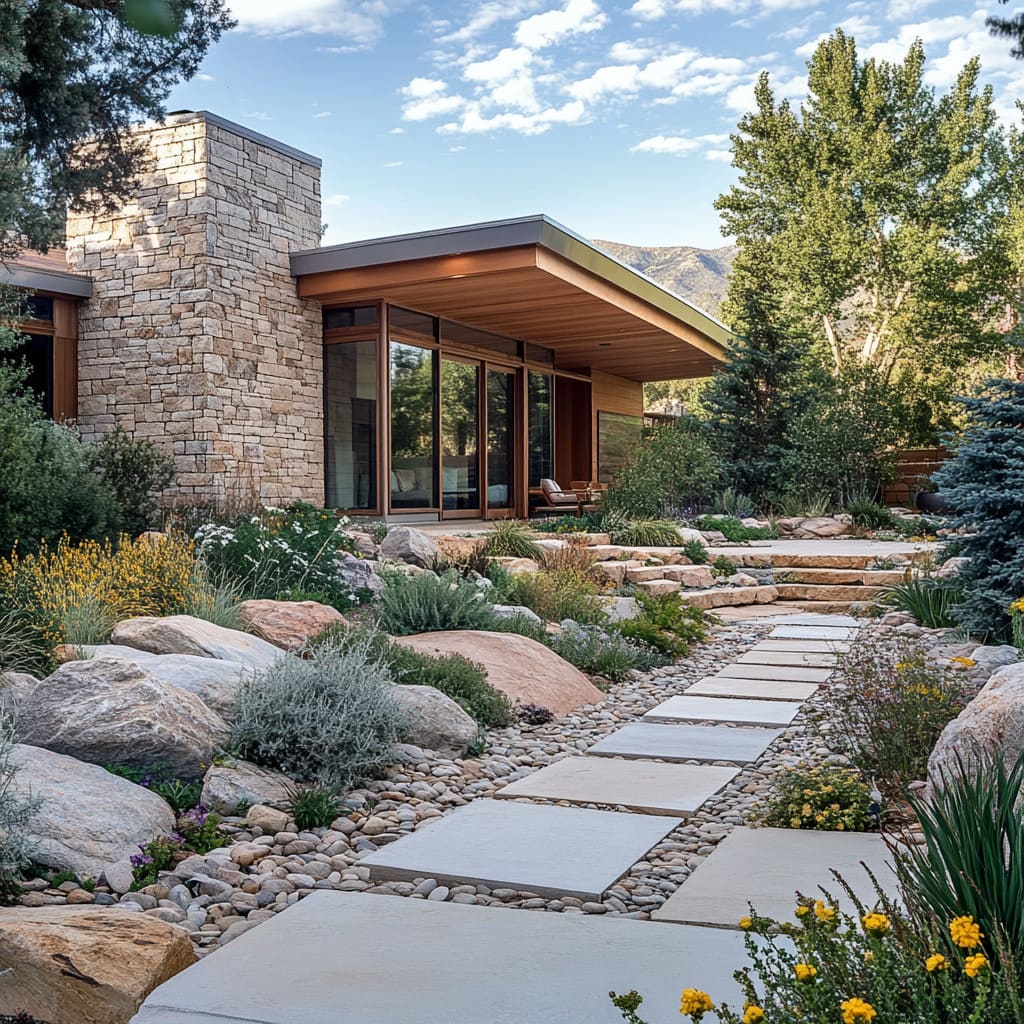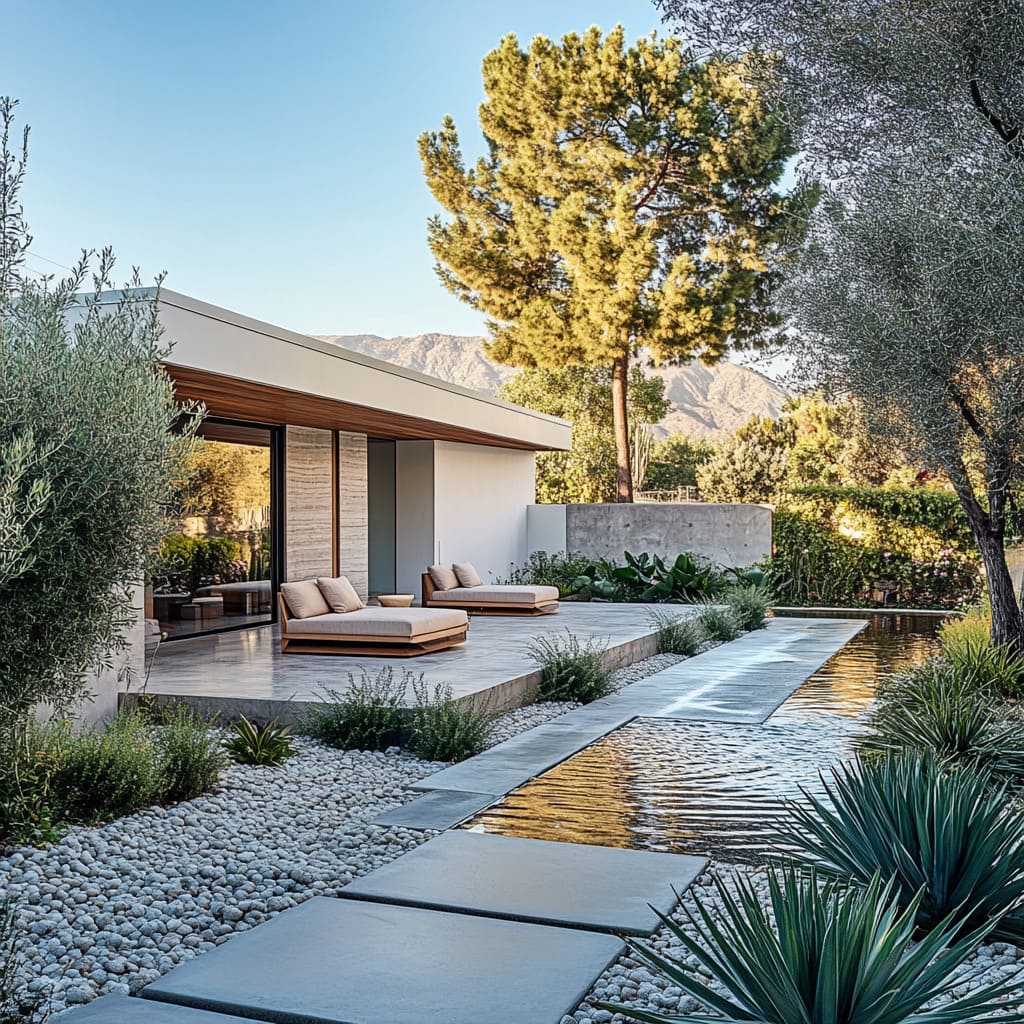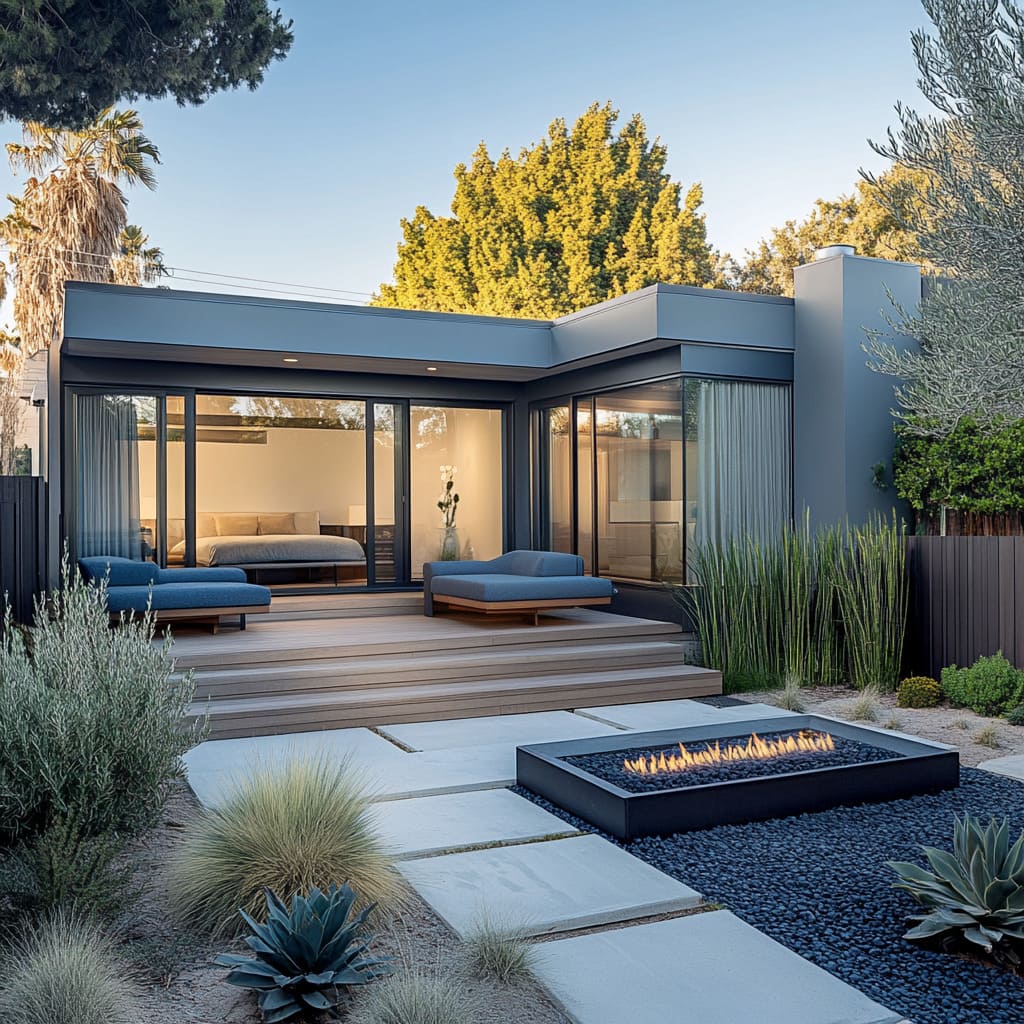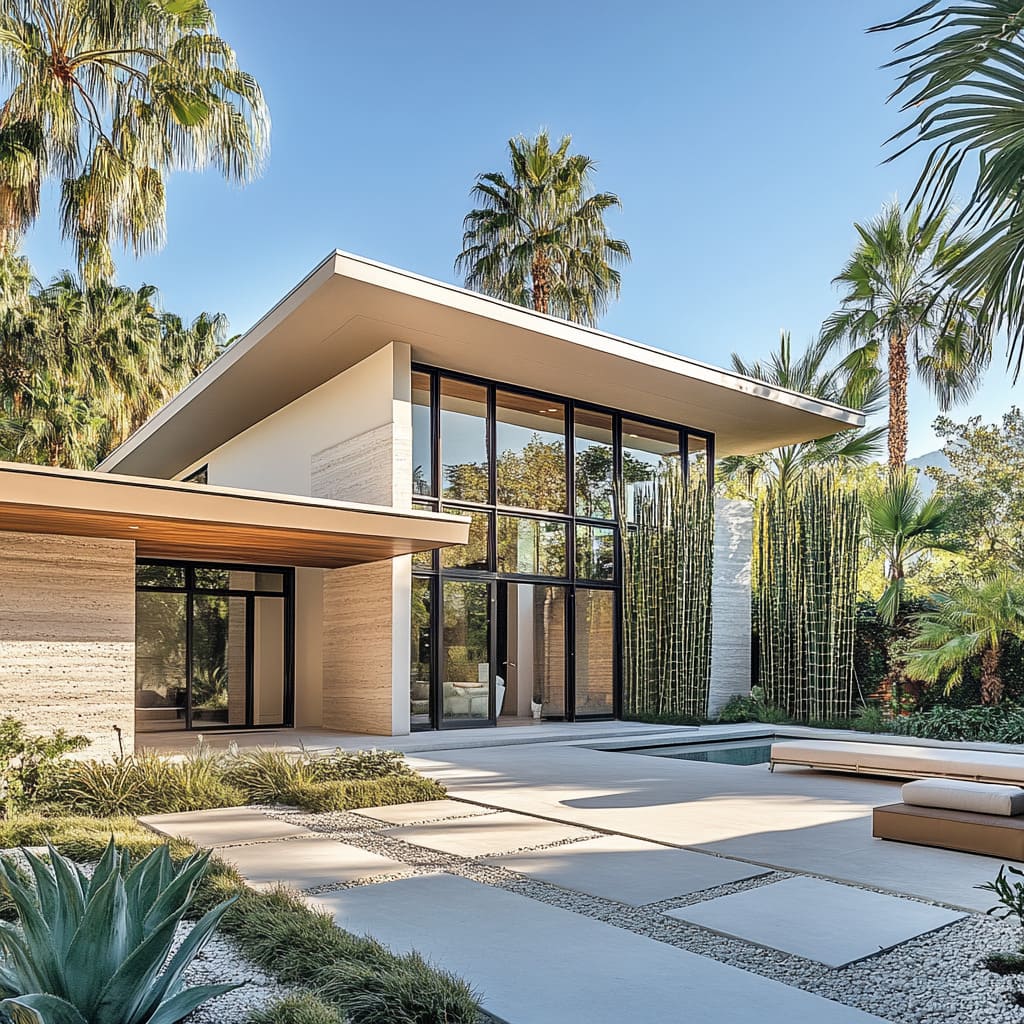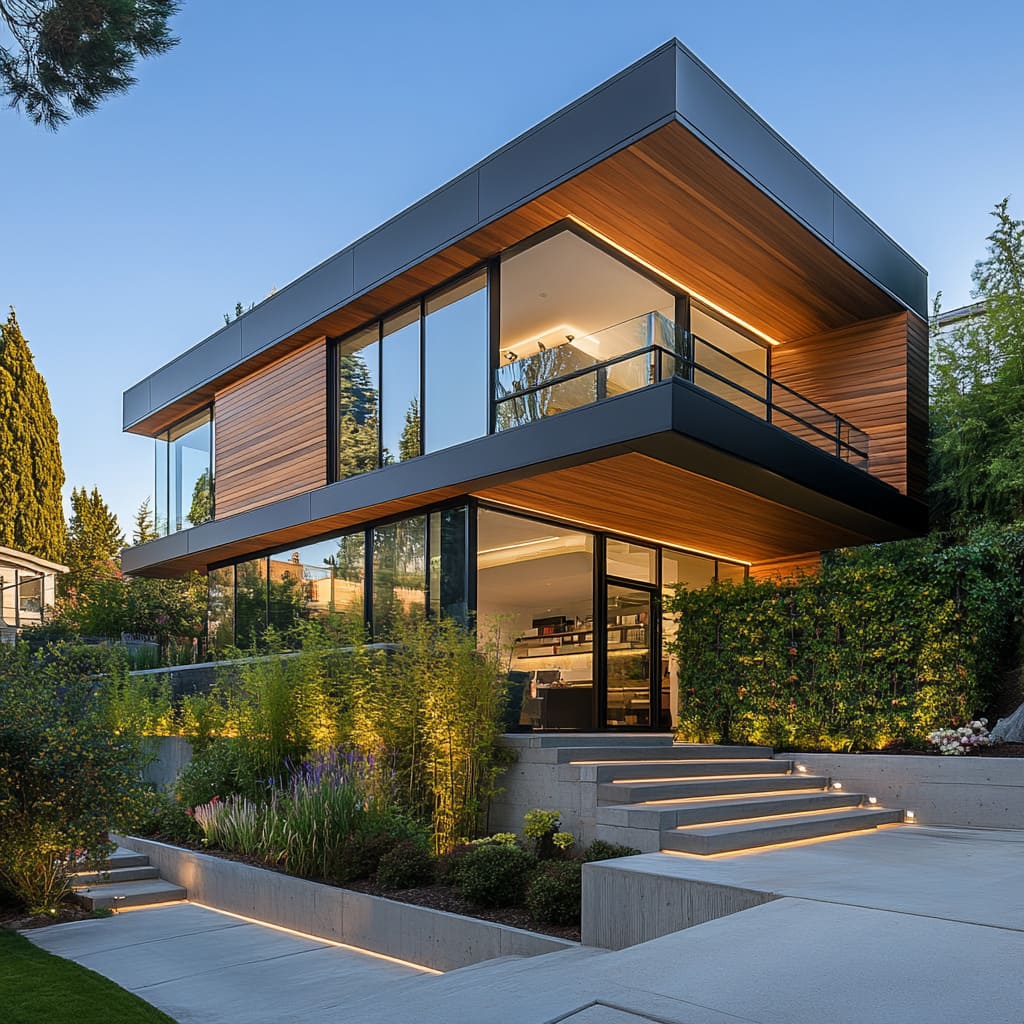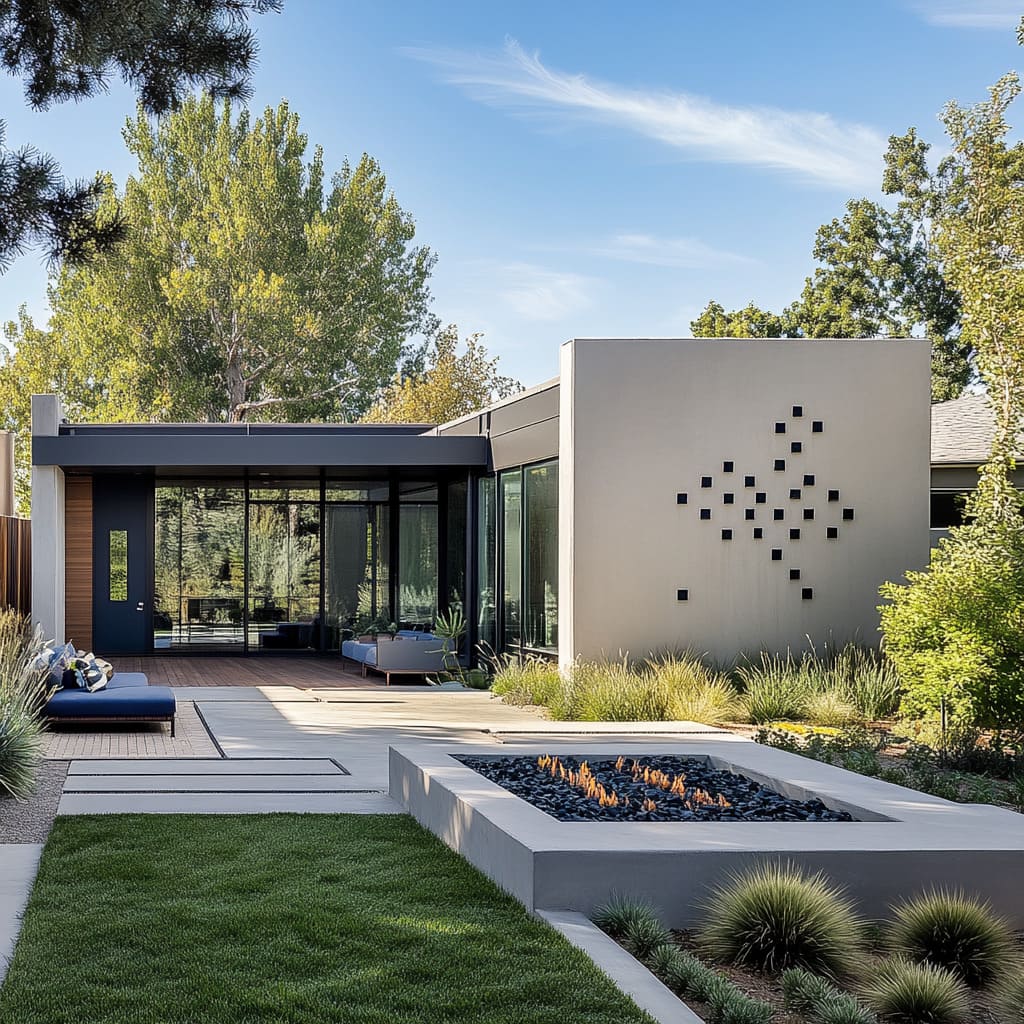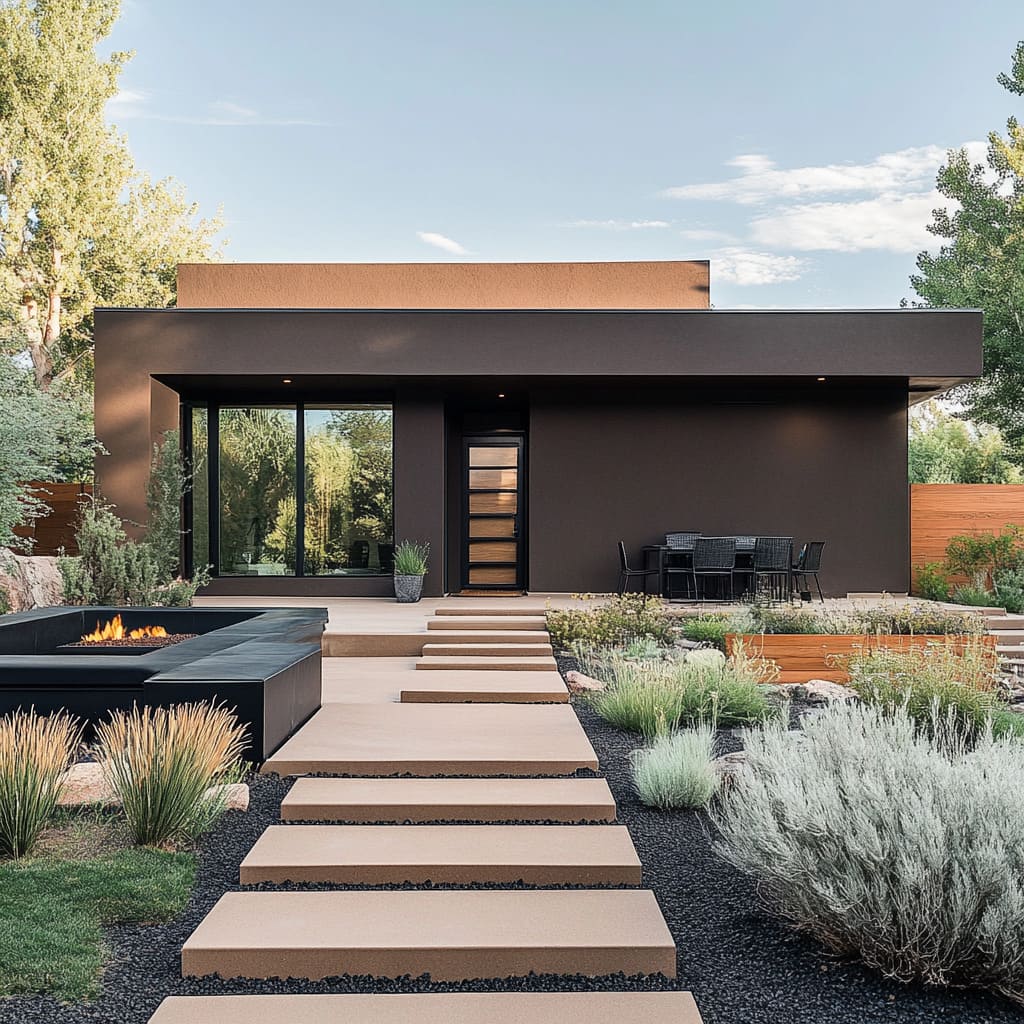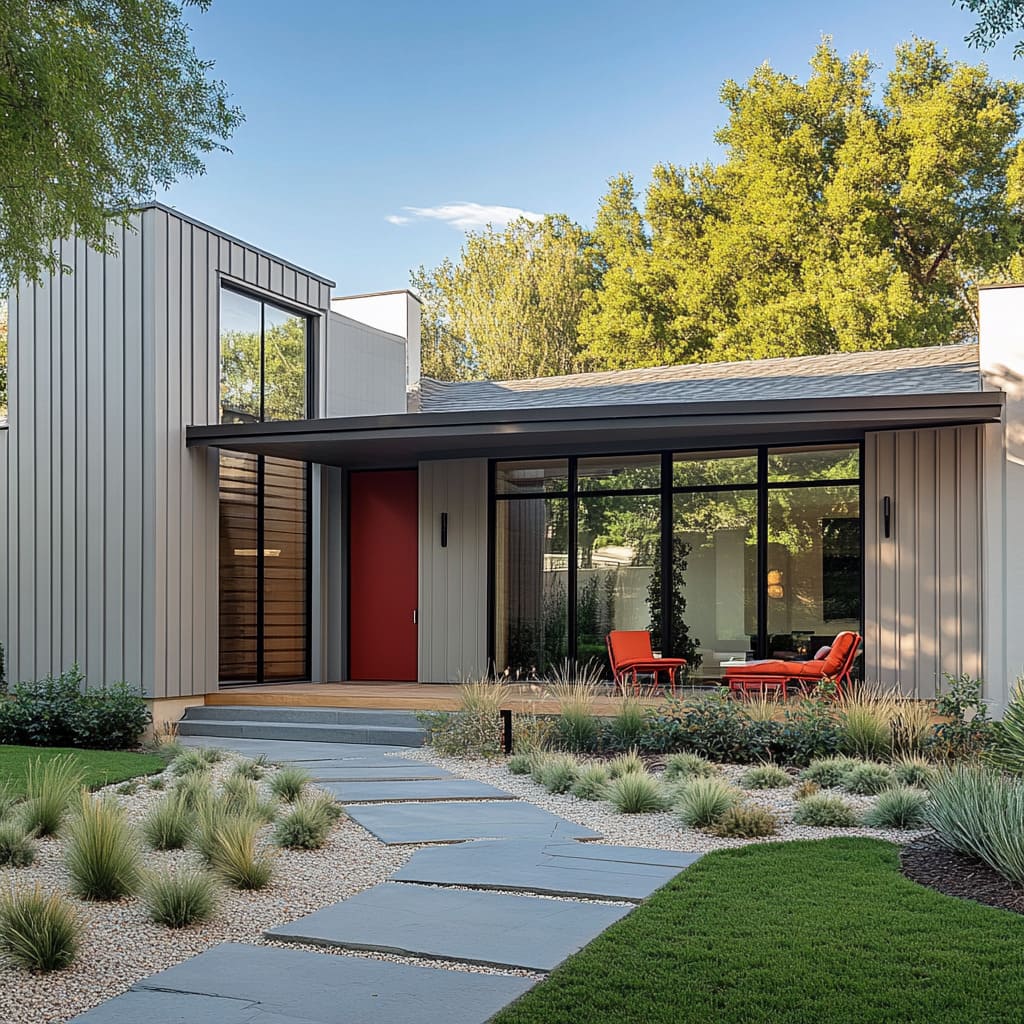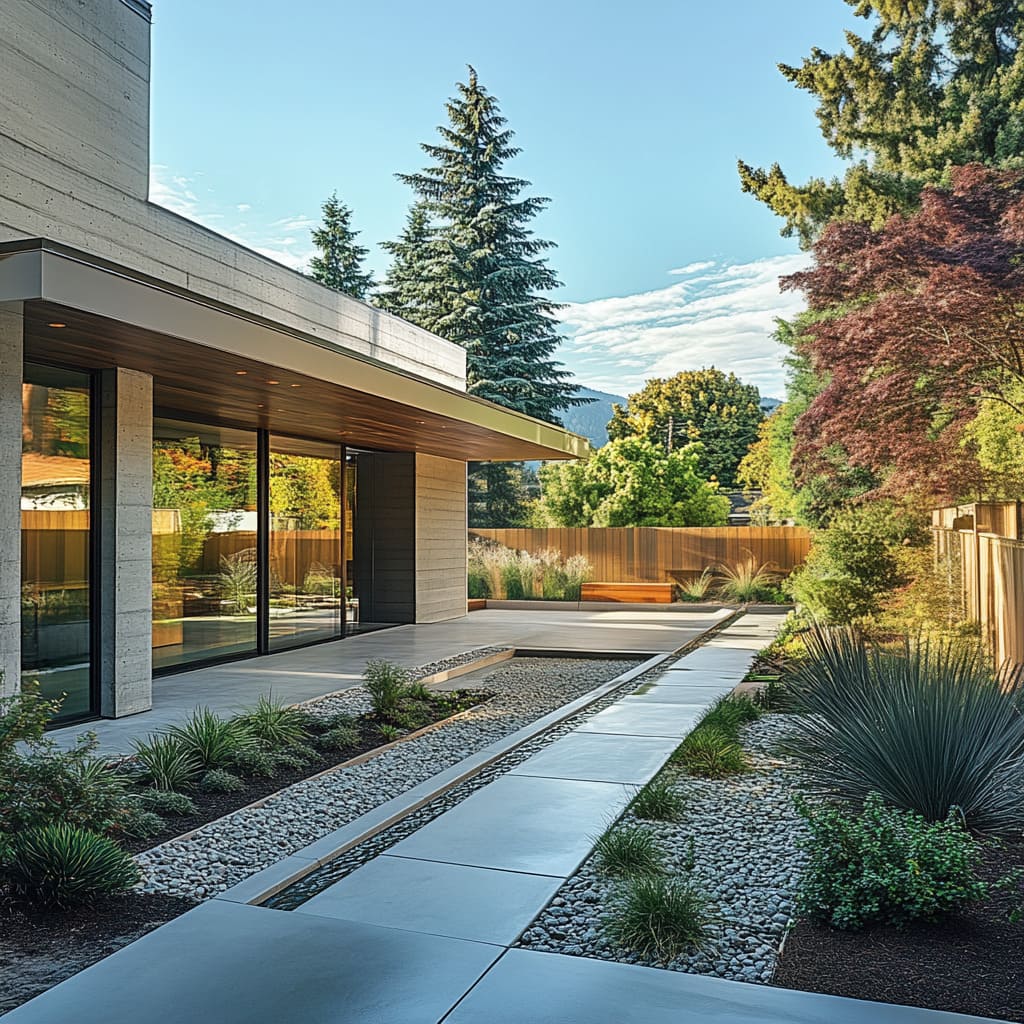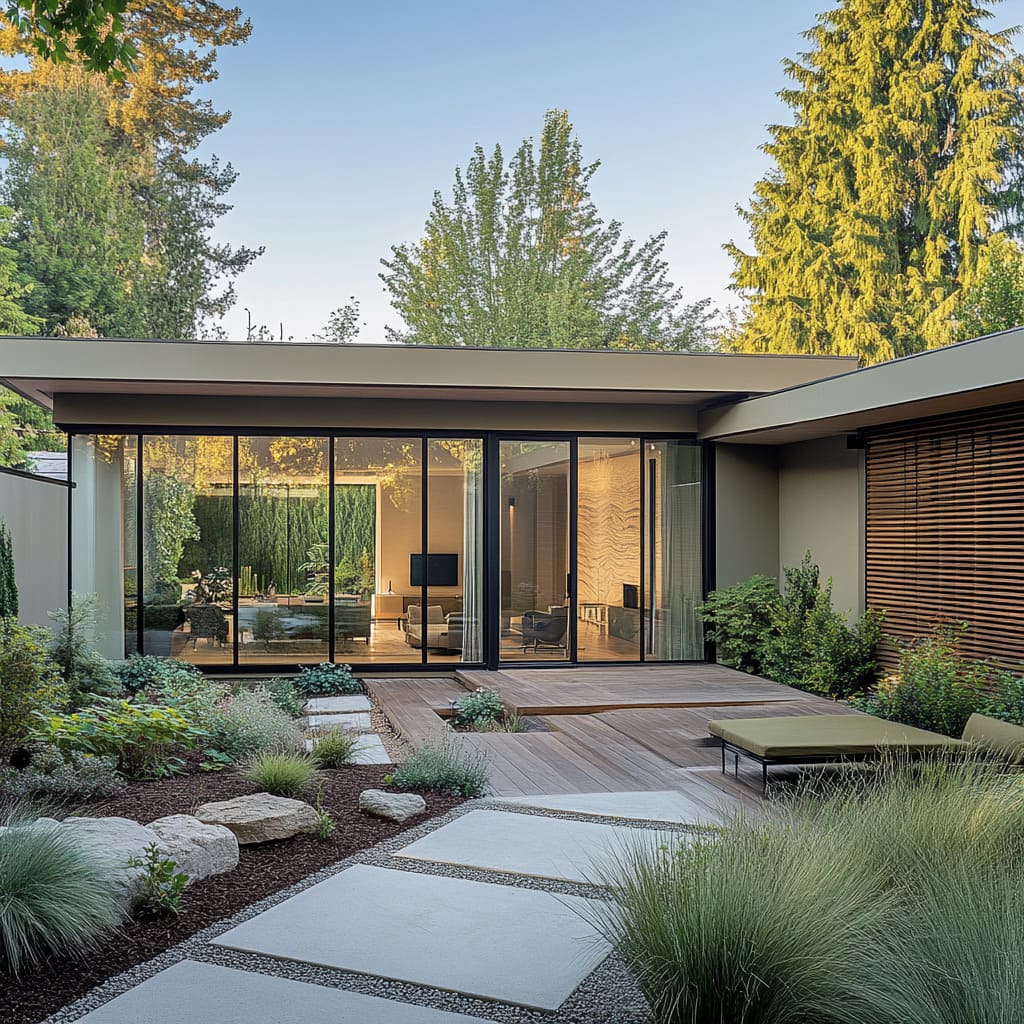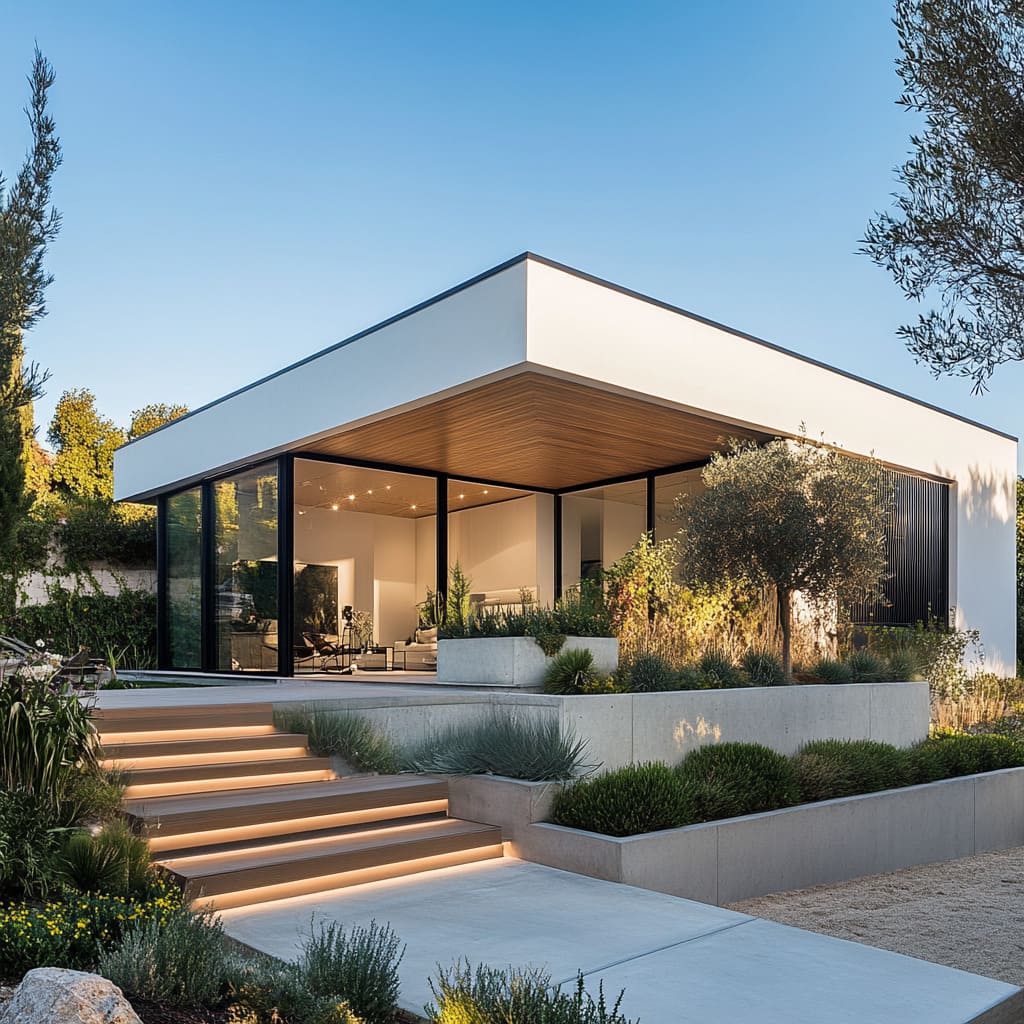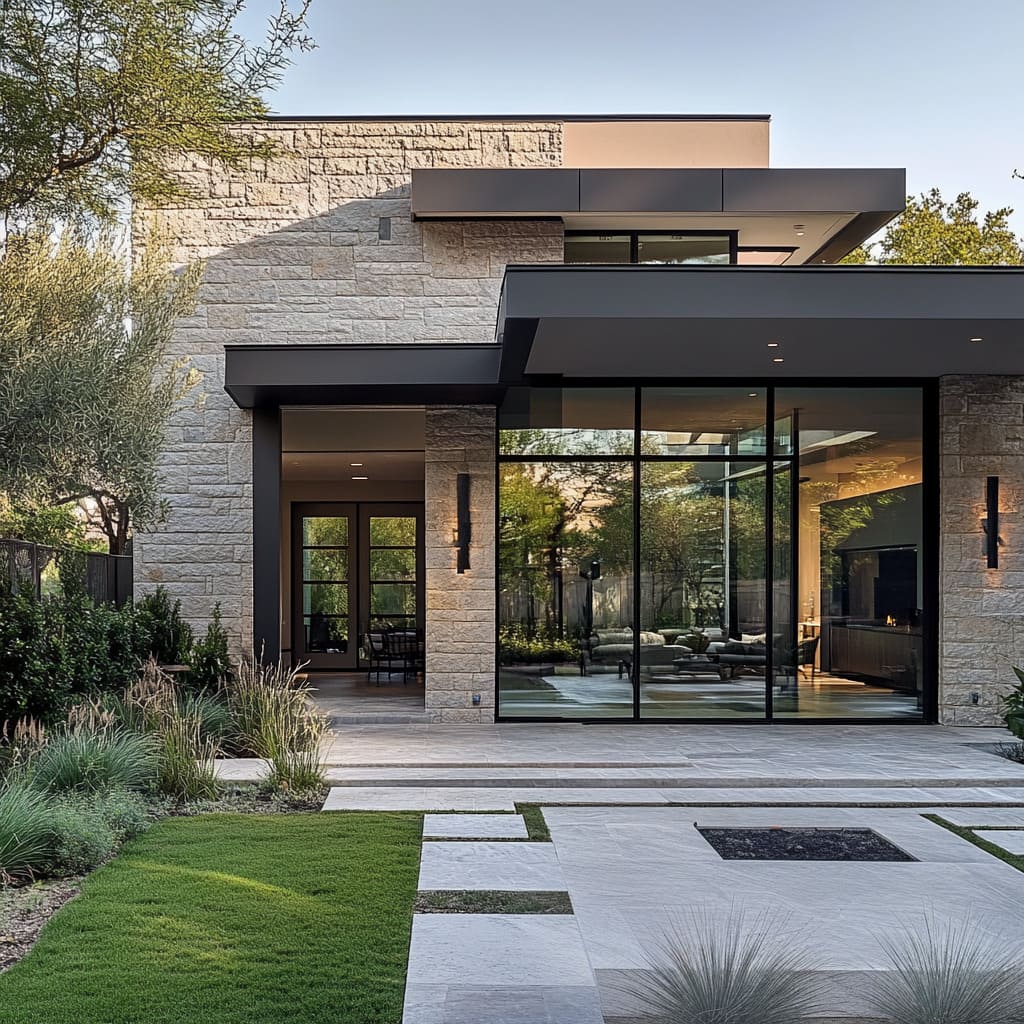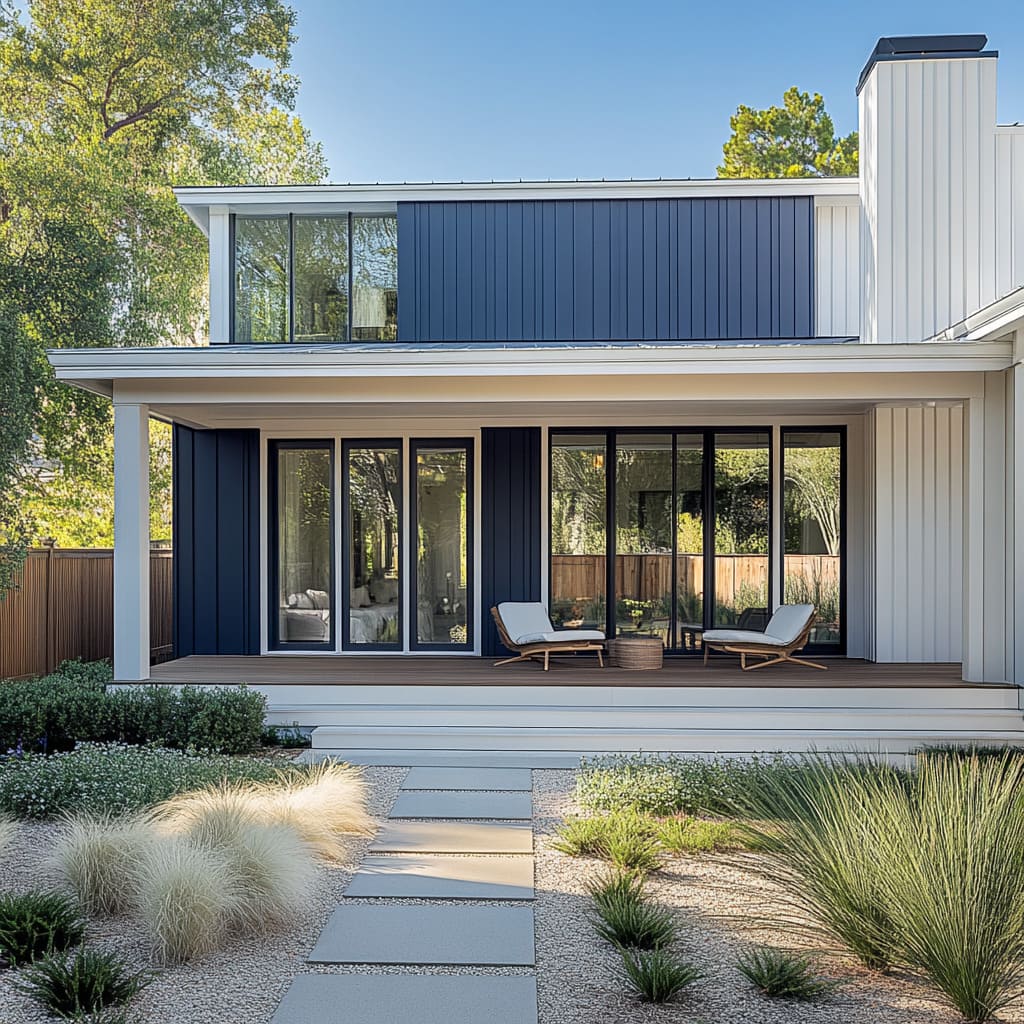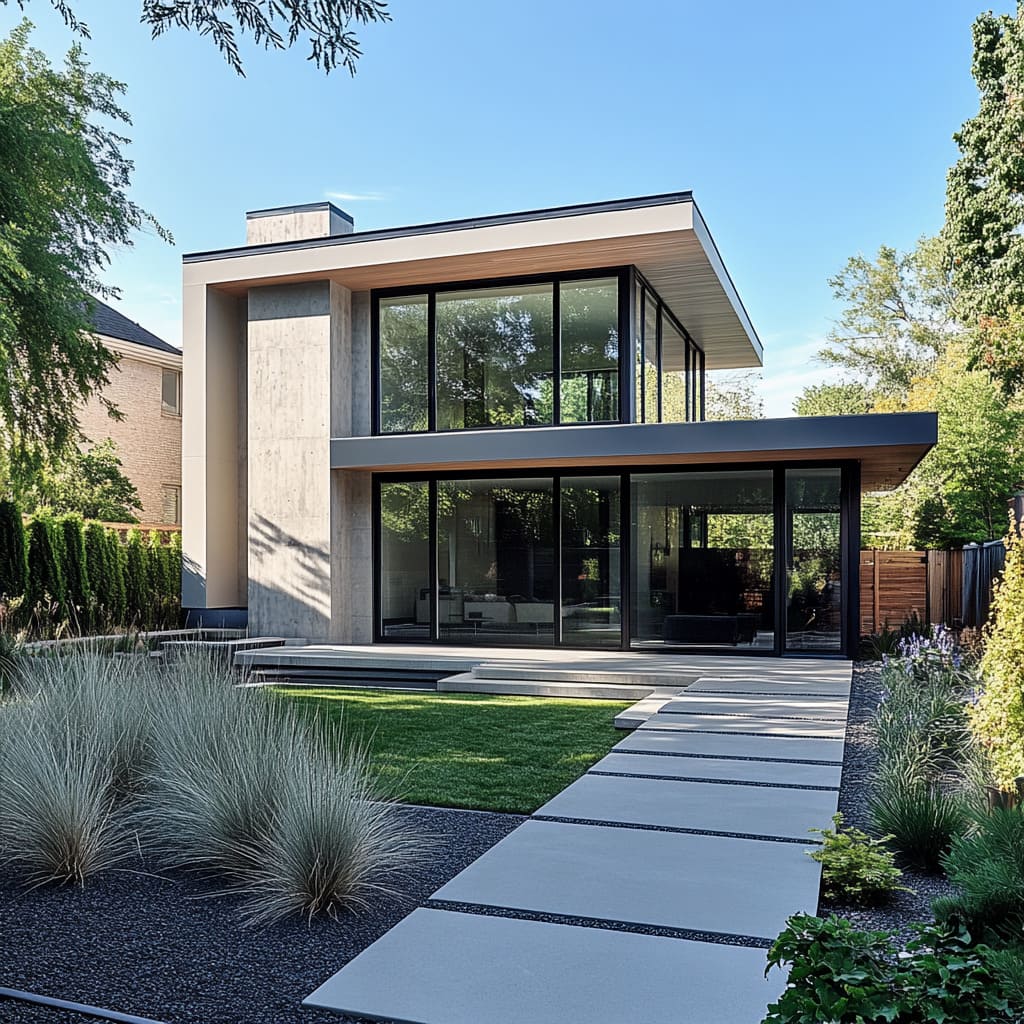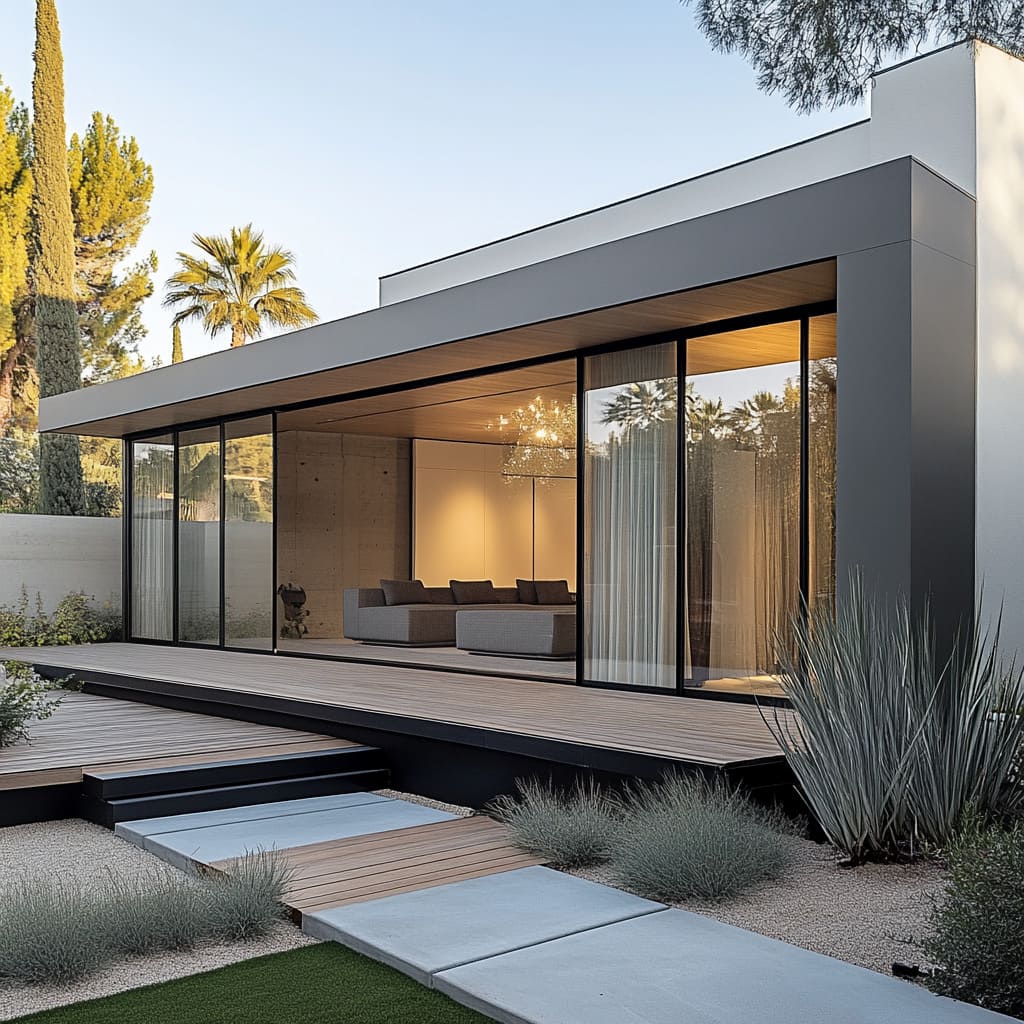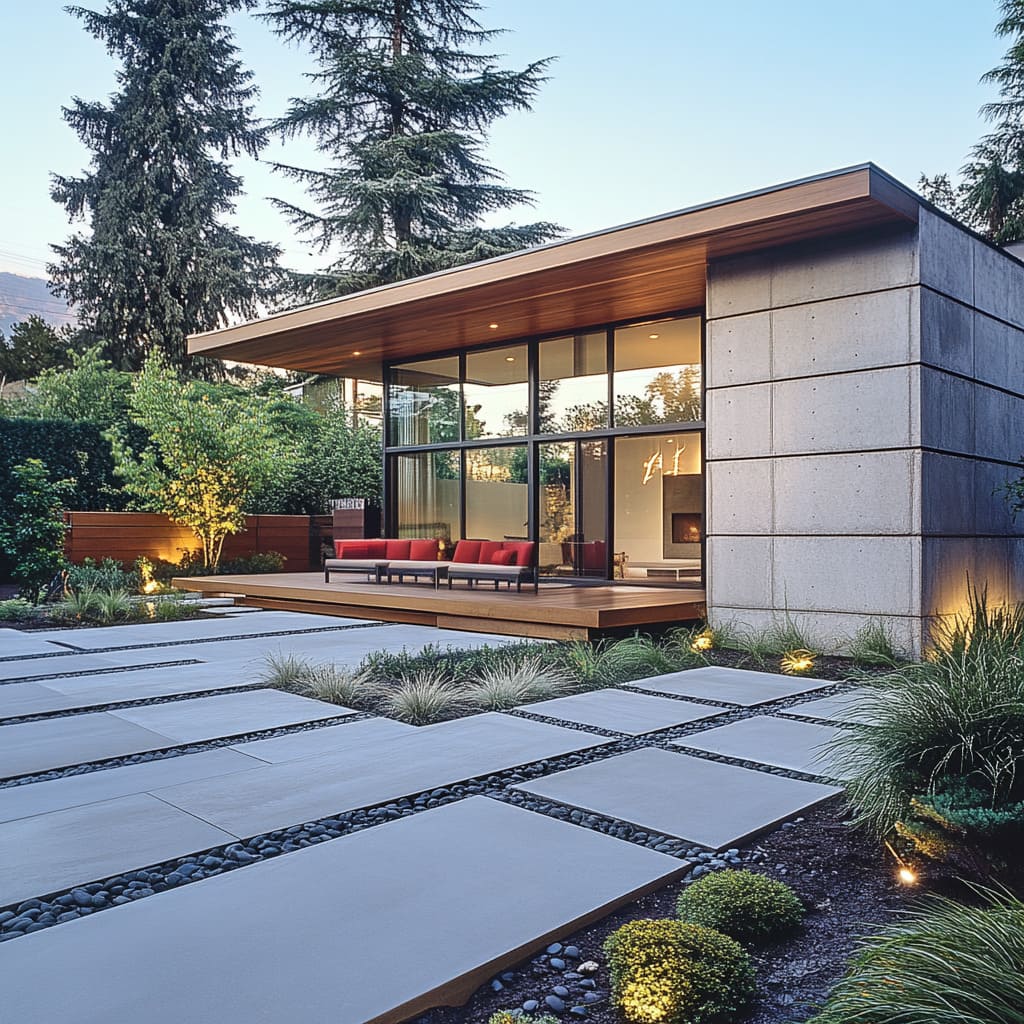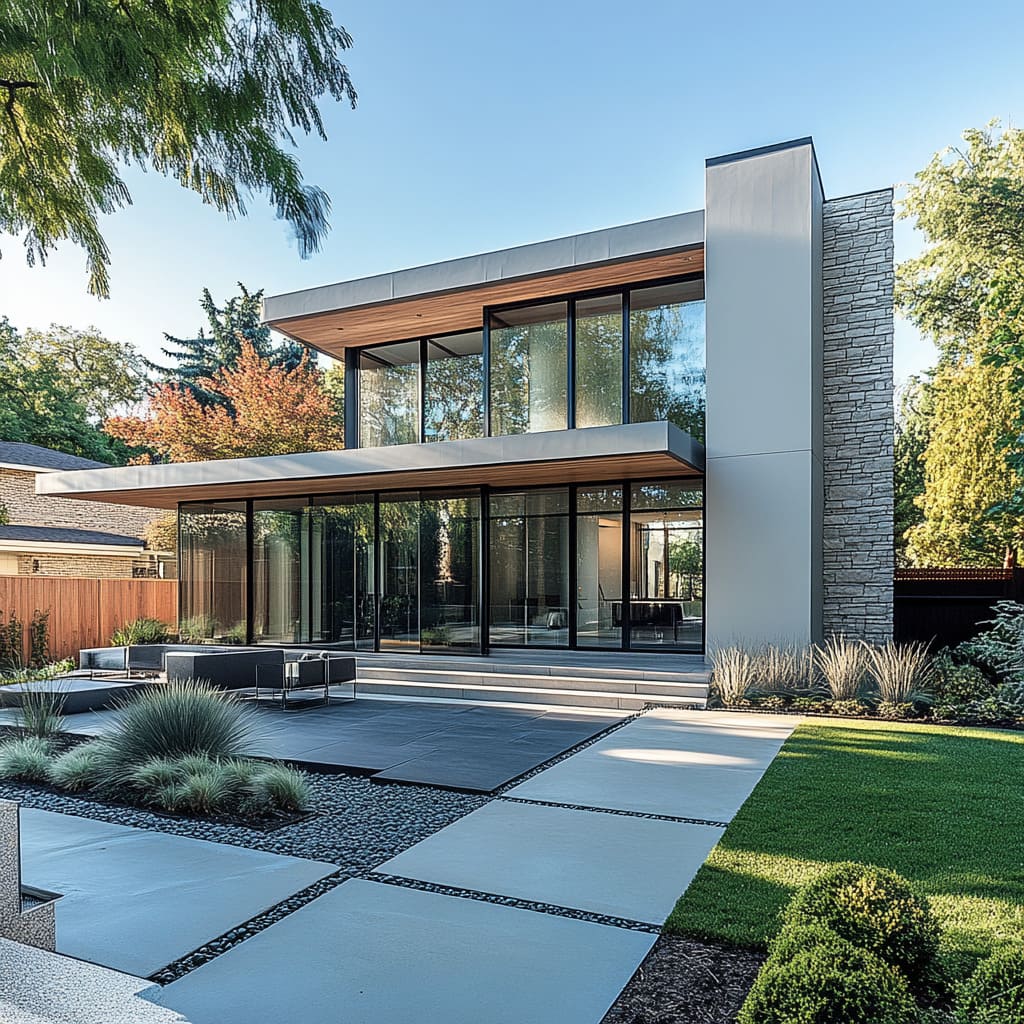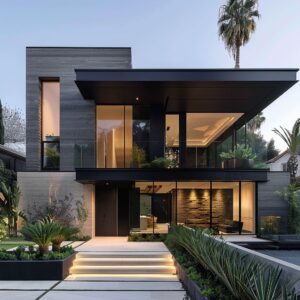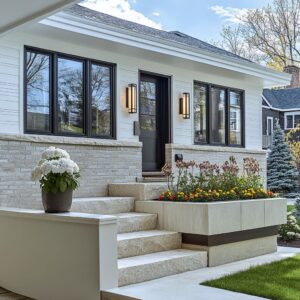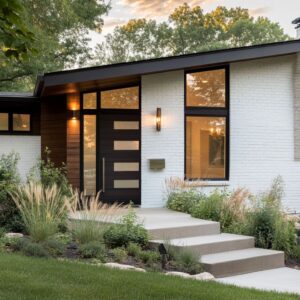Modern home design is no longer confined to rigid categories—it’s an artful blend of influences and elements that create stylish, functional spaces with timeless appeal. From sleek geometric lines to thoughtful connections with the surrounding environment, these homes redefine how we think about exterior design.
Whether you’re drawn to minimalist forms, natural materials, or innovative landscaping ideas, this guide explores the essential principles and creative approaches that bring these designs to life. With a focus on balancing aesthetics and practicality, we’ll uncover how the right choices in architecture, materials, and landscaping can transform any home into a standout example of contemporary style.
Modern Home Design: Styles and Key Influences
Stylish and eye-catching modern houses often embody a thoughtful combination of modernist, minimalist, and mid-century modern styles. These designs are further enriched by influences from Japandi, Scandinavian, and contemporary organic aesthetics, creating homes that stand out with an unmistakable character.
This blend results in homes that feel both contemporary and timeless, showcasing a harmonious mix of functionality and visual appeal. To achieve a standout modern house design, it’s essential to focus on the following key elements that define these sought-after styles.
Clean Geometric Forms
At the heart of modern home design ideas is simplicity in shape and structure. Flat or low-pitched roofs dominate the aesthetic, creating a sleek and balanced horizontal profile.
Facades are intentionally kept simple, free of excessive ornamentation, relying instead on clean lines and angular features to convey sophistication. Linear symmetry, whether vertical or horizontal, ensures a cohesive and polished overall look.
Connection to Nature
Modern designs prioritize blending indoor and outdoor spaces seamlessly. Large floor-to-ceiling windows are not only visually striking but also invite natural light into the home while providing unbroken views of surrounding greenery.
Many designs integrate landscaped gardens, courtyards, or patios as key focal points, reinforcing the connection between the house and its environment. Open layouts with sliding glass doors further enhance this interaction, encouraging a free flow of light and air.
Material Contrast
A defining characteristic of these homes is the artful combination of contrasting materials. Warm woods—whether used as cladding, soffits, or decking—add natural charm and texture.
These are paired with sleek metals, often seen in window frames, railings, or trim, to introduce a sense of modernity and refinement. Smooth stone surfaces, such as polished concrete or subtle-textured panels, offer balance and a grounding effect.
Together, these materials create an exterior that feels rich and layered without overwhelming the design.
Beauty in Functionality
Every element in these homes is thoughtfully designed to serve a purpose while enhancing the overall visual appeal. Overhangs, for example, aren’t merely decorative; they provide shade and reduce glare, improving energy efficiency.
Similarly, landscaping is designed not just for aesthetics but also for practicality, whether it’s for erosion control, privacy, or creating defined spaces for outdoor living. This approach ensures that the exterior is as functional as it is visually appealing.
Eco-Conscious Design
Sustainability is a key consideration in modern house design. Drought-tolerant plants, used extensively in landscaping, minimize water consumption while maintaining lush and attractive outdoor areas.
Energy-efficient glazing, combined with thoughtful window placement, reduces heat transfer and enhances insulation. These choices not only contribute to the home’s environmental friendliness but also create long-term cost efficiencies for homeowners.
By embracing these principles, modern homes achieve an impressive balance between timeless style and everyday functionality. Whether drawing inspiration from Scandinavian simplicity or the warmth of mid-century design, these elements work together seamlessly to define homes that are as practical as they are visually stunning.
How Styles Are Reflected in Design Elements
Modern homes achieve their distinctive look through a thoughtful application of design elements, reflecting the blend of simplicity, functionality, and aesthetic appeal. The contemporary house design principles focus on harmony between architecture, landscaping, materials, and color palettes, ensuring every detail contributes to the home’s cohesive visual impact.
Architectural Features
The architecture of modern homes prioritizes sleek lines, symmetry, and a deliberate focus on horizontality.
- Roofs: Flat or low-pitched roofs are hallmarks of modern design, creating a streamlined silhouette that enhances the home’s grounded presence. Extended overhangs not only add visual interest but also serve a functional purpose, offering shade to reduce heat exposure during warm months.
- Windows: Floor-to-ceiling glass panels blur the boundaries between the interior and exterior, creating a seamless connection with nature. These expansive windows flood the spaces with natural light while offering unobstructed views, enhancing the feeling of openness. Reflective glass or thin black frames emphasize the clean aesthetic of modern style home design.
- Facades: Modern facades are characterized by their textural contrasts, combining wood cladding, stucco, and stone to achieve visual depth. Vertical and horizontal siding patterns alternate, adding layers of interest to otherwise simple surfaces. This design choice highlights the play between geometry and materiality.
- Entrances: The entryway is a focal point of modern design. Minimalistic and bold, these entrances often feature wide, solid doors finished in vibrant colors like navy or red, or in warm, natural wood tones. These elements provide an inviting touch while maintaining the sleek and uncluttered aesthetic.
Landscaping Elements
The exterior landscaping of a modern home is as much a design statement as the architecture, focusing on clean transitions and eco-conscious choices.
- Pathways: Stepping stones or concrete slabs, framed by gravel or greenery, create structured pathways that guide visitors to the home. Their alignment with the architectural geometry reinforces the clean, modern aesthetic.
- Plants: Landscaping prioritizes drought-resistant plants such as ornamental grasses, succulents, and shrubs. These plants offer low-maintenance solutions while adding texture and diversity to the outdoor space. Their sustainability aligns with the eco-friendly principles often embraced in contemporary design.
- Levels: Multi-level landscaping introduces layers of visual complexity. Retaining walls, tiered gardens, and elevated patios enhance both functionality and beauty, creating pockets of usable space that integrate seamlessly with the home’s architecture.
- Lighting: Subtle yet impactful, LED strip lighting is incorporated along pathways, steps, or rooflines. This lighting not only enhances safety but also emphasizes key design features after sunset, adding an ambient glow that enhances the nighttime appearance of the home.
Material Combinations
A defining feature of modern homes is the thoughtful use of materials that create contrast while complementing each other.
- Wood: Warm wood tones, applied to soffits, decking, and cladding, bring a natural softness to modern exteriors, balancing the more industrial elements. The organic appeal of wood connects the home to its surroundings.
- Metal: Metals are used sparingly but effectively in frames, railings, and accents, with finishes in black or dark bronze. These elements provide a striking contrast to the natural tones of wood and stone, contributing to the home’s contemporary edge.
- Stone: Natural or textured stone serves as a grounding material, often used in walls, fireplaces, or retaining structures. Its raw, tactile quality contrasts beautifully with smoother surfaces, like stucco or glass.
- Glass: Frameless or reflective glass creates an air of transparency and sleekness. By allowing light to pass through and reflect off surfaces, glass panels contribute to the open and spacious feel synonymous with modern designs.
Color Palette
The color palette of modern homes is deliberately restrained, relying on neutral tones to create a timeless and sophisticated look. ul>
By combining these elements thoughtfully, modern homes achieve a balance of form and function, creating visually compelling exteriors that are both stylish and practical. The integration of clean lines, sustainable landscaping, and a harmonious material palette makes these homes a timeless example of modern design principles.
How Elements Work Together for Cohesive Design
Modern home design is all about achieving a perfect harmony between form and function, where every element works in concert to create a seamless and captivating exterior. A thoughtful combination of materials, shapes, and transitions ensures that the design feels both unified and purposeful.
Let’s explore how these elements come together to form a cohesive and visually striking look.
Balance of Materials
The interplay of contrasting materials is at the heart of modern design. The warmth of natural elements such as wood and stone balances the sleek coolness of glass and metal, creating a visual equilibrium that feels inviting yet contemporary.
For example, warm wooden soffits soften the sharp edges of metal-framed windows, while stone accents ground the structure, anchoring it firmly within the landscape. This balance is particularly evident in modern 2 storey house design, where the verticality of the structure can be softened by the horizontal lines of wooden cladding or stone features, giving the house both stature and approachability.
Using materials with varying textures adds another layer of depth. Smooth glass panels and polished metal frames contrast beautifully with the rugged surface of stacked stone or the natural grain of timber.
This thoughtful contrast prevents the design from feeling monotonous while ensuring all materials complement one another rather than compete.
Functional Aesthetics
Every feature in modern homes is carefully designed to serve a dual purpose—practical and visual. Overhangs, for instance, are a common element that adds both shade and architectural character.
These projections protect interiors from harsh sunlight while enhancing the home’s clean, geometric lines. Similarly, recessed lighting, often tucked under rooflines or embedded into pathways, provides subtle illumination while emphasizing architectural details and creating a welcoming ambiance after sunset.
Landscaping also plays a pivotal role in functional aesthetics. Drought-resistant plants such as succulents and ornamental grasses not only thrive in arid conditions but also contribute to the home’s modern aesthetic with their structured forms and varied textures.
Retaining walls or tiered gardens, often integrated into modern home design ideas, are functional elements that prevent soil erosion while adding dimension and layering to the outdoor space.
Indoor-Outdoor Unity
A defining characteristic of modern design is the seamless connection between indoor and outdoor spaces. Large glass doors and floor-to-ceiling windows are not just stylistic choices; they blur the boundaries between the home’s interior and exterior.
These features flood the home with natural light while framing views of the surrounding landscape, making nature an integral part of the design. This sense of unity extends to the materials used both inside and out.
Wooden cladding on exterior walls often continues into the interior ceilings or walls, creating a sense of continuity. Similarly, patios and decks are frequently designed with materials that mirror indoor flooring, further reinforcing the idea of a shared, cohesive space.
Repetition of Geometry
Repetition is a key principle in achieving a cohesive design. Modern homes are characterized by their use of consistent geometric shapes and lines.
For instance, the rectangular forms found in pathways, window frames, and facade cladding are echoed in the shapes of planters or even furniture, creating a harmonious visual rhythm. In modern 2 storey house design, this repetition might appear in the alignment of upper and lower windows or in the stacked arrangement of balconies and terraces.
These recurring shapes tie the various elements of the design together, ensuring the structure feels unified from every angle.
The Final Harmony
Ultimately, the success of a modern home lies in its ability to integrate these elements into a cohesive whole. The balance of warm and cool materials, the dual-purpose nature of design features, the seamless flow between indoor and outdoor spaces, and the repetition of geometric forms all contribute to a design that feels intentional and complete.
This approach ensures that every aspect of the home, from its architecture to its landscaping, works in harmony to create a striking yet livable space.
Design Approaches and Principles to Follow
Creating a modern exterior design house requires more than just selecting materials and colors—it involves adopting a thoughtful set of principles that prioritize simplicity, functionality, and connection to the surrounding environment. By carefully combining these elements, homeowners can achieve a sophisticated and cohesive exterior that stands out while remaining timeless.
Simplicity in Form
Modern exterior design thrives on clean lines and geometric shapes. Avoid unnecessary ornamentation or decorative details that detract from the clarity of the design.
Flat or low-pitched roofs, rectangular or cubic volumes, and straightforward layouts are hallmarks of this style. The focus is on letting the form speak for itself.
This simplicity makes the design feel grounded and intentional, offering a backdrop that allows other elements, such as landscaping or material choices, to shine. Think of it this way: simplicity doesn’t mean boring; it means refined.
A straightforward facade with expansive glass panels or smooth stucco can create an understated elegance, proving that restraint often results in the most impactful designs.
Material Layering
To create depth and visual interest, layering multiple materials is essential. A successful modern exterior often combines at least three contrasting textures, such as wood, stone, and metal.
For example, warm wooden cladding adds a sense of natural coziness, stone provides a sense of solidity and permanence, and sleek metal accents contribute a contemporary edge. These materials complement each other while ensuring the design remains balanced.
The key is to select materials that contrast in texture but harmonize in tone. For instance, pairing light stone with rich, dark wood and matte black metal creates an inviting yet bold aesthetic.
This approach allows each material to play a distinct role while contributing to the overall cohesiveness of the house.
Focus on Connection
Modern exterior design emphasizes a seamless relationship between the house and its surroundings. Expansive windows, sliding glass doors, and open floor plans blur the boundaries between indoor and outdoor spaces.
This connection allows natural light to flood interiors while offering uninterrupted views of the landscape, making nature an integral part of the home. For houses in areas with picturesque surroundings, this principle is especially valuable.
Large glass walls can frame outdoor scenery as if it were art, adding an organic dynamic to the overall design. Sliding doors that lead to patios or decks further enhance this connection, creating a sense of flow and encouraging outdoor living.
Functional Landscaping
Landscaping is more than a decorative feature in modern design—it plays an integral role in complementing the architecture and enhancing the house’s practicality. Retaining walls, for example, are not just structural elements; they can be beautifully integrated with the design, serving as planters or seating areas.
Similarly, tiered gardens or steps create a layered effect, adding dimension and blending seamlessly with the building’s geometry. Sustainability is also a priority.
Using drought-tolerant plants like succulents, ornamental grasses, and native species not only reduces water consumption but also aligns with the modern ethos of environmental consciousness. This approach creates a landscape that feels intentional and enduring.
Subtle Accentuation
While modern design focuses on minimalism, small accents can make a powerful impact when used thoughtfully. These accents might include an eye-catching feature wall, a boldly colored front door, or carefully curated lighting.
For example, a deep navy or vibrant red door can create a striking focal point without overwhelming the design. Lighting, too, is a subtle yet transformative detail.
Linear LED strips along pathways or staircases provide a warm glow, accentuating architectural features and ensuring safety. Similarly, wall-mounted fixtures in clean, geometric shapes can enhance the facade while remaining unobtrusive.
Bringing It All Together
The magic of modern exterior design lies in the way these principles come together to create a cohesive and inviting home. Simplicity in form ensures clarity, material layering adds depth, and a focus on connection integrates the house with its environment.
Meanwhile, functional landscaping and subtle accents elevate the design, making it both practical and visually engaging. By following these approaches, any home can be transformed into a space that feels modern, stylish, and deeply connected to its surroundings—an exterior that truly embodies the essence of modern design.
Creative Ideas for Remodeling
Transforming a home’s exterior to align with sleek and stylish modern aesthetics involves a strategic approach that balances aesthetics and functionality. Here’s how to infuse contemporary charm into your remodeling project with well-thought-out ideas that prioritize visual appeal and practicality.
Facade Enhancements
One of the most impactful ways to refresh a home’s exterior is by reimagining its facade. Modern exterior cladding ideas include combining materials like smooth stucco and natural wood cladding to create depth and texture.
This contrast of warm and cool materials adds an eye-catching dynamic to the house, ensuring it stands out without feeling overbearing. Incorporating vertical or horizontal siding can further highlight the geometry of the structure, giving it a modern edge.
Vertical siding emphasizes height, while horizontal lines suggest expansiveness, making these choices particularly effective depending on the proportions of your home. For a bold transformation, consider replacing a pitched roof with a flat or low-pitched version featuring extended overhangs.
This sleek silhouette is a hallmark of contemporary design and offers practical benefits like shading windows during hot weather.
Windows and Entrances
Updating windows and entryways can dramatically change the perception of a home. Replace smaller windows with expansive floor-to-ceiling glass panels or sliding doors.
These elements not only modernize the facade but also flood interiors with natural light and create a seamless connection to outdoor spaces. Entrance doors are another opportunity to make a strong impression.
Opt for a bold, solid wood or steel design that feels substantial and secure. A statement color like navy or deep red can serve as a focal point, while natural finishes exude understated elegance.
Modern home ideas often emphasize these inviting yet minimalist entrances, blending aesthetic appeal with functionality.
Landscaping
A thoughtfully designed landscape can significantly enhance a modern exterior. Stepping stone pathways, surrounded by gravel and drought-tolerant plants, reflect the simplicity and geometry inherent in modern design.
These pathways not only provide a practical solution but also contribute to the overall aesthetic cohesion. Tiered gardens filled with native or ornamental plants add depth and dimension to outdoor spaces.
This approach is not only visually engaging but also environmentally friendly, requiring less water and maintenance. To elevate the design further, consider LED strip lighting along pathways, garden beds, or exterior stairs.
This subtle illumination adds a touch of sophistication, making outdoor areas feel welcoming even after dark.
Outdoor Living Spaces
Modern homes often emphasize a connection to the outdoors, and creating versatile outdoor living spaces is key. Decks or patios crafted from natural materials like wood or stone provide the perfect transition between the house and the yard.
These areas can serve as extensions of indoor living spaces, offering places to relax or entertain. Introducing a fire pit or water feature can act as a focal point in the yard, drawing attention and encouraging social gatherings.
Privacy screens, whether through landscaping walls or hedges, create intimate zones that enhance usability without compromising the open feel of the design.
Lighting and Details
Lighting plays a vital role in emphasizing modern architectural features. Recessed lighting in roof overhangs or soffits provides a minimalist glow that highlights the clean lines of the design.
Additionally, indirect lighting under stairs or along pathways can subtly draw attention to these features while improving safety. Exterior fixtures in black or bronze finishes complement the modern aesthetic, offering a polished yet unobtrusive detail.
These fixtures, when paired with the overall design, create a harmonious look that feels both cohesive and intentional.
Bringing It All Together
By layering these creative remodeling ideas, you can transform any home into a modern masterpiece. From embracing material contrasts to enhancing outdoor spaces, these strategies ensure a stylish and functional design.
Modern exterior cladding ideas and thoughtful landscaping choices are essential for creating a cohesive look that reflects contemporary sensibilities. Whether your goal is a complete overhaul or targeted updates, these principles provide a roadmap for success.
Key Insights for Cohesive Modern Design
Crafting a visually appealing and functionally sound modern design requires attention to proportions, materials, and sustainability while adhering to the principles of minimalism. These elements work together to define the foundation of modern residential architecture and create spaces that feel balanced, purposeful, and timeless.
Prioritize Proportions
Proportions are a cornerstone of cohesive modern design. The size and placement of windows, doors, and pathways should complement the overall structure to maintain a harmonious aesthetic.
Oversized windows paired with sleek frames allow for abundant natural light without overpowering the facade. Pathways that align geometrically with the house’s architecture create a sense of continuity, guiding the eye and ensuring every element feels intentional.
Entryways play a critical role in setting the tone for the design. A bold entrance door, scaled proportionately to the home’s size, offers a focal point without overwhelming the structure.
This attention to scale ensures a clean and unified look that feels neither sparse nor overly complex.
Blend Natural and Industrial Elements
The interplay between natural materials and industrial finishes is key to creating a modern exterior that is both sophisticated and inviting. Wood and stone introduce warmth and texture, softening the sleekness of metals and concrete.
For example, integrating stone walls with black steel accents bridges the gap between earthy authenticity and urban chic. This combination not only defines the aesthetic but also adds durability and versatility.
Natural materials are often used in modern home exteriors for their timeless appeal, while industrial elements like concrete or metal ensure longevity and functionality. Balancing these materials creates a layered design that feels dynamic and approachable.
Focus on Sustainability
Sustainability is no longer just an afterthought in modern design—it’s an integral part of creating homes that are as responsible as they are beautiful. The use of drought-tolerant plants and environmentally friendly materials enhances both functionality and aesthetics.
Landscaping with native plants reduces water consumption, while the inclusion of gravel or permeable pavers minimizes runoff and supports eco-conscious practices. For construction, opting for materials with a low environmental impact—such as reclaimed wood or recycled metal—aligns with the principles of modern residential architecture.
These choices not only contribute to the home’s visual appeal but also demonstrate a commitment to thoughtful, sustainable living.
Keep It Minimal
Minimalism remains a defining feature of modern design. Every element included in the exterior should serve a clear purpose, whether functional, aesthetic, or both.
Clean lines and uncluttered forms are the hallmark of this approach, ensuring the design remains timeless and adaptable. Lighting, for example, is often integrated subtly within the architecture.
Recessed lighting under overhangs or along pathways provides both illumination and emphasis without detracting from the structure’s simplicity. Similarly, flat or low-pitched roofs with extended eaves deliver practicality through sun shading while maintaining a sleek, minimalist profile.
Achieving Cohesion Through Design
At the heart of cohesive modern design is a seamless integration of all these elements. Proportions guide the overall balance, while natural and industrial materials create contrast and interest.
Sustainability ensures the design is both functional and forward-thinking, and minimalism ties everything together into a visually clean and intentional aesthetic. By applying these insights, homeowners can achieve a modern exterior that resonates with contemporary sensibilities while standing the test of time.
Whether you’re inspired by sleek urban settings or serene suburban landscapes, these principles provide a strong foundation for creating a home that feels thoughtful, stylish, and uniquely yours.
Conclusion
Creating a cohesive and stylish modern home exterior requires more than just surface-level upgrades—it’s about understanding how each element works together to achieve harmony. By combining clean forms, a thoughtful mix of materials, and sustainable landscaping, homeowners can craft spaces that feel both visually striking and deeply functional.
Whether you’re planning a full remodel or looking for small ways to refresh your exterior, the insights and ideas shared here offer a blueprint for success. Modern home design isn’t just about trends; it’s about creating a home that feels intentional, welcoming, and truly reflective of today’s architectural values.
